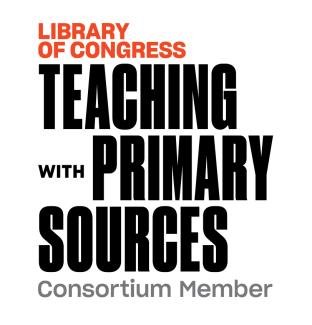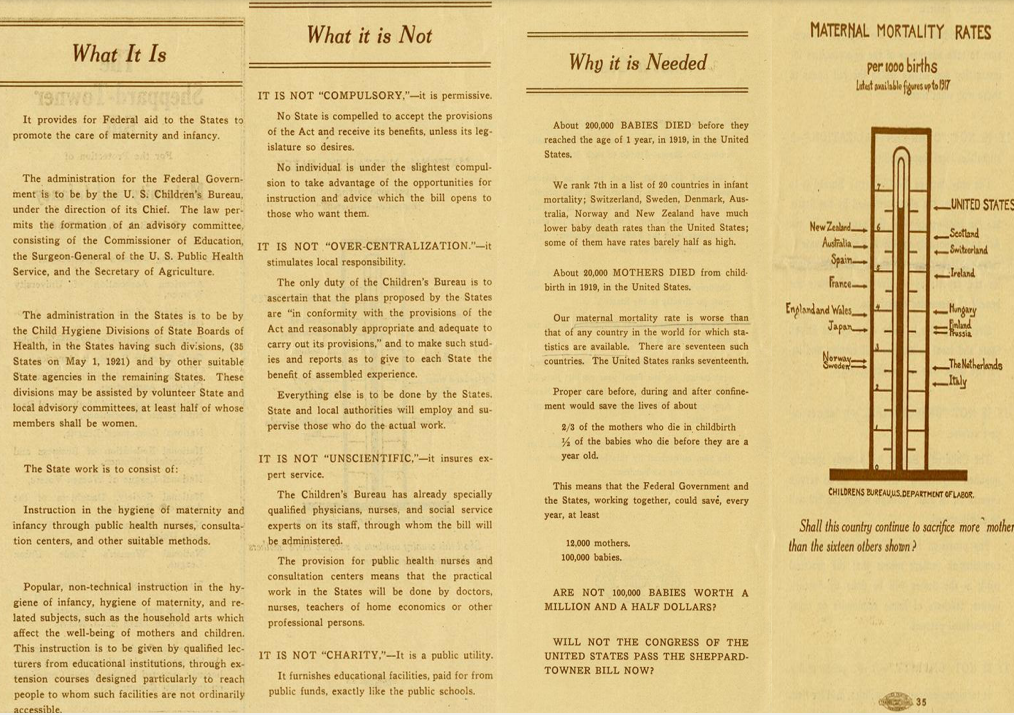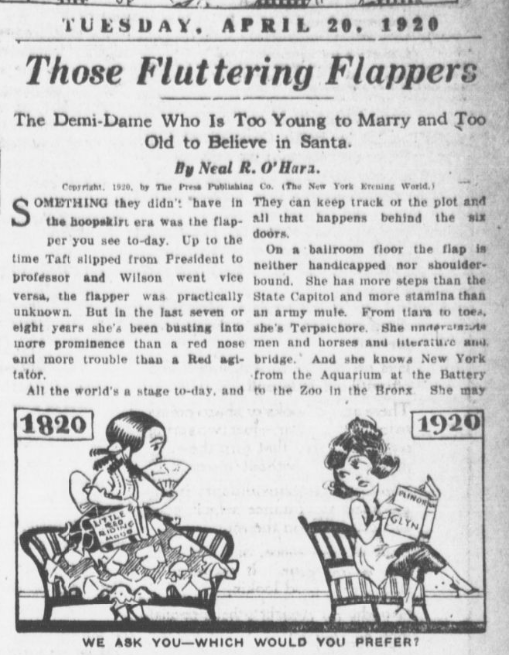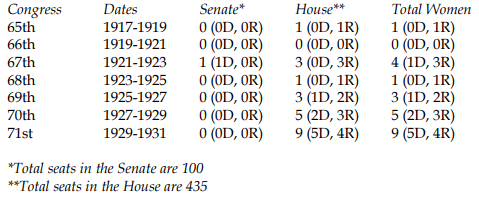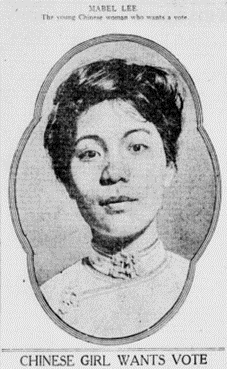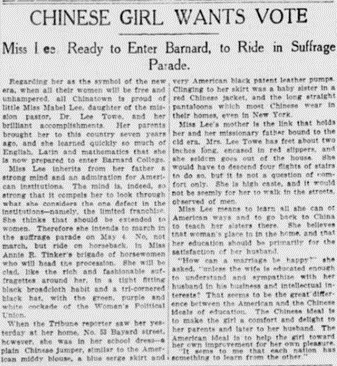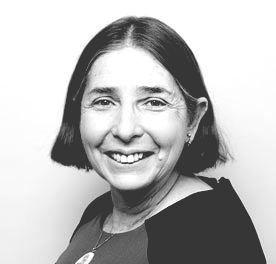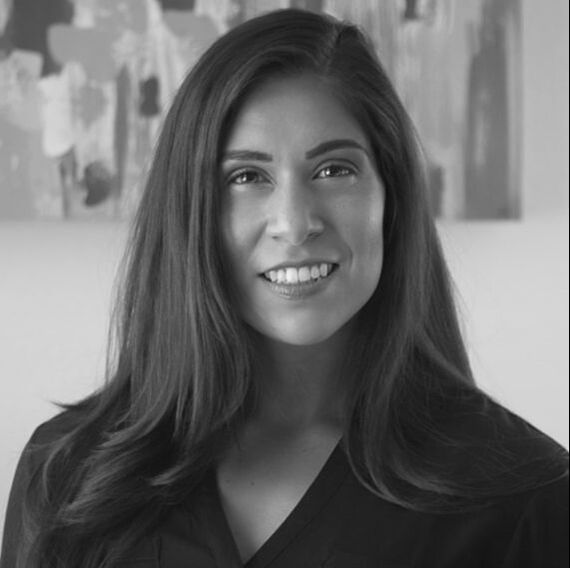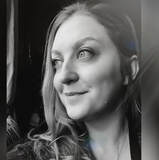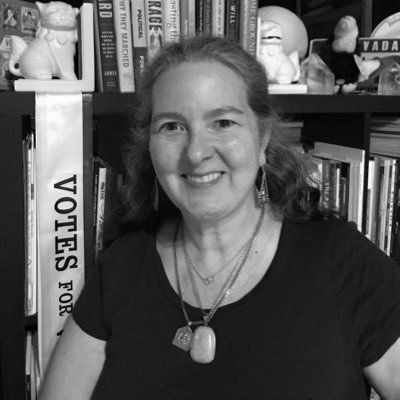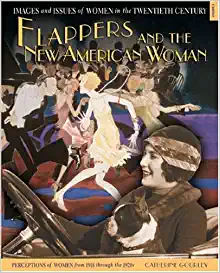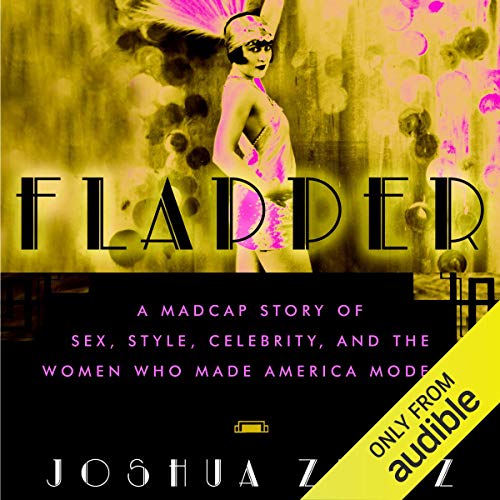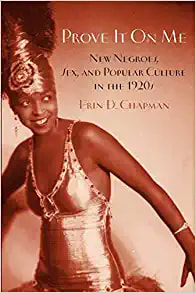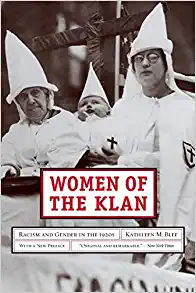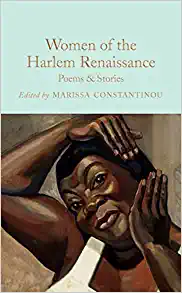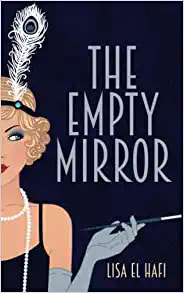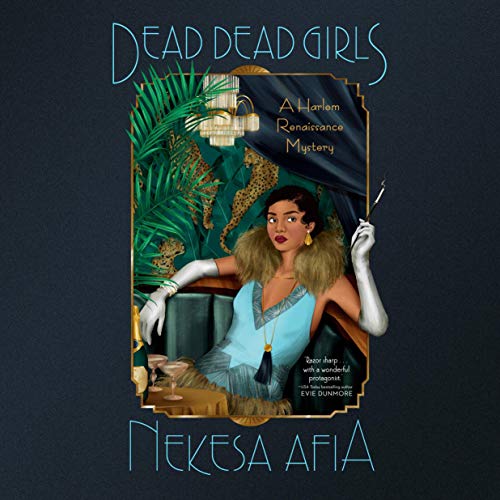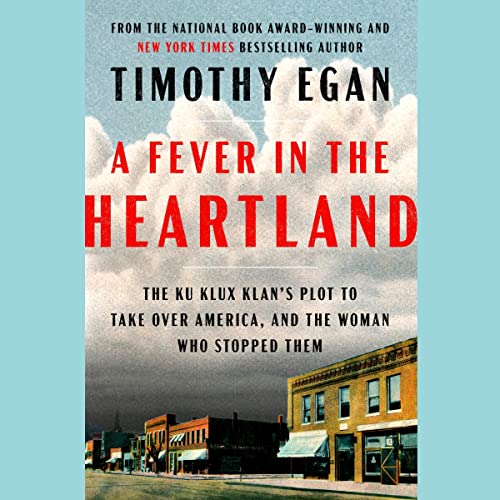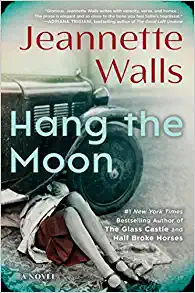17. The New Woman
|
The period between 1919 and the Stock Market Crash of 1929 “roared.” Who roared and why gives us some interesting things to examine in this episode. The term “Roaring Twenties” brings to mind cultural rebellion, frivolity, and assertions of independence, especially for women. From working girls in growing cities to flappers, Miss America, the Harlem Renaissance, and women athletes, the decade was exciting. But the 1920s began with profound conservatism and ended with the collapse of the American economy.
|
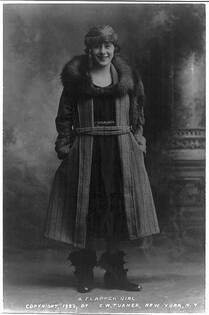 A Flapper Girl, Library of Congress
A Flapper Girl, Library of Congress
The period between 1919 and the Stock Market Crash of 1929 “roared.” Who roared, who did not roar, and why gives us some interesting things to examine in this episode. The term “Roaring Twenties” brings to mind cultural rebellion, frivolity, and assertions of independence, especially for women. From working girls in growing cities to flappers, Miss America, the Harlem Renaissance, and women athletes, the decade was exciting. But the 1920s began with profound conservatism and ended with the collapse of the American economy.
Isolation, Xenophobia, and the KKK:
After winning a war to “make the world safe for democracy,” the United States entered a period of isolation from the rest of the globe. Congress refused to ratify the Treaty of Versailles or join the League of Nations, and the tone of the time promoted “America First,” leaving the rest of the world alone.
Isolation, Xenophobia, and the KKK:
After winning a war to “make the world safe for democracy,” the United States entered a period of isolation from the rest of the globe. Congress refused to ratify the Treaty of Versailles or join the League of Nations, and the tone of the time promoted “America First,” leaving the rest of the world alone.
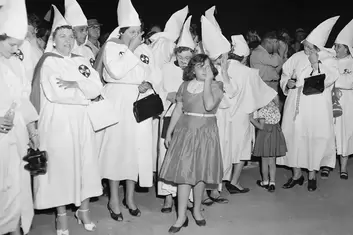 The Women's KKK, JSTOR
The Women's KKK, JSTOR
Hostility to immigrants from Eastern and Southern Europe and hostility to the theory of evolution were aspects of the conservative tone of the decade. Both promoted the defense of a white, Protestant, rural vision of America. Women were active participants in the effort to prevent the teaching of evolution in schools. They also donned the white robes of the separatist and racist Ku Klux Klan. The Women’s KKK, maintained autonomy from the male run and operated KKK, and had about 500,000 members between 1923 and 1930 all over the United States. They recruited members using coded phrases like “pure womanhood,” “American” rights, and asking questions in advertisements that appeared in Protestant church bulletins, “Do you not want American teachers in our American schools?” Members spread rumors and gossip about Jewish and Catholic businessmen and received a lot of support from non-WKKK members in consumer boycotts against the businessmen. WKKK members also engaged in letter writing campaigns to clean-up the movie industry, which they saw as promoting immoral behavior. They also visited public schools and distributed Bibles or copies of the Ten Commandments and tried to get Catholic teachers fired.
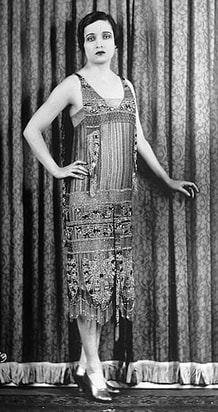 Alice Joyce, Wikimedia Commons
Alice Joyce, Wikimedia Commons
Prohibition:
Prohibition was perhaps the second greatest success of women’s political activism of the 19th and early 20th century. Women activists also fought to prevent Americans from manufacturing, distributing, or selling alcoholic beverages. However, anti-alcohol sentiment also echoed hostility to Catholic and Jewish immigrants and the dense cities in which they lived. Drinking was blamed for a decline in American morality, and women supporters of Prohibition saw themselves as guardians of moral purity.
But even the most determined women who decried alcohol as evil could not prevent Americans from drinking. The Eighteenth Amendment proved impossible to enforce. Illegal sale and distribution contributed to illegal drinking, a tide that would not be easily stemmed. Desiring equality, young women demonstrated that they too could consume forbidden alcohol.
Flappers:
The conservative spirit of the 1920s co-existed with the popular image of the “Roaring Twenties,” and the “New Woman.” Her generation saw significant gains in college attendance and participation in the salaried workforce, where there were 8 million women by 1920. Women worked as teachers, nurses, and office workers. While these professions were “feminized,” they afforded opportunities for women to thrive independently. Political feminism seemed to be replaced with social feminism, where greater freedoms in daily life became more important than additional political rights. The predominant image of the period was the sophisticated young woman who smoked and drank, bobbed her hair, and knew her own mind. She was the flapper.
Prohibition was perhaps the second greatest success of women’s political activism of the 19th and early 20th century. Women activists also fought to prevent Americans from manufacturing, distributing, or selling alcoholic beverages. However, anti-alcohol sentiment also echoed hostility to Catholic and Jewish immigrants and the dense cities in which they lived. Drinking was blamed for a decline in American morality, and women supporters of Prohibition saw themselves as guardians of moral purity.
But even the most determined women who decried alcohol as evil could not prevent Americans from drinking. The Eighteenth Amendment proved impossible to enforce. Illegal sale and distribution contributed to illegal drinking, a tide that would not be easily stemmed. Desiring equality, young women demonstrated that they too could consume forbidden alcohol.
Flappers:
The conservative spirit of the 1920s co-existed with the popular image of the “Roaring Twenties,” and the “New Woman.” Her generation saw significant gains in college attendance and participation in the salaried workforce, where there were 8 million women by 1920. Women worked as teachers, nurses, and office workers. While these professions were “feminized,” they afforded opportunities for women to thrive independently. Political feminism seemed to be replaced with social feminism, where greater freedoms in daily life became more important than additional political rights. The predominant image of the period was the sophisticated young woman who smoked and drank, bobbed her hair, and knew her own mind. She was the flapper.
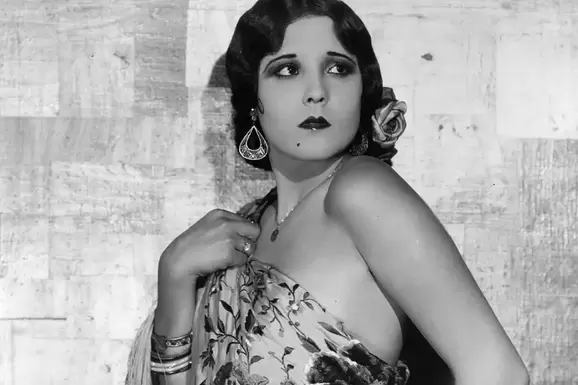 Raquel Torres "La Pelona", JSTOR
Raquel Torres "La Pelona", JSTOR
The flapper was young, rebellious, and fiercely independent. Short skirts, bobbed hair, makeup, and lots of jewelry were all part of the flapper style that influenced fashion in the 1920s. The flapper was the ultimate in sophistication, and women, especially in America’s growing cities, wanted to emulate her. The flapper, largely a product of the middle class, was not confined to the white middle class. Native Americans, African Americans, and Hispanic young women also became flappers as well, and joined in the rebellion against parental authority.
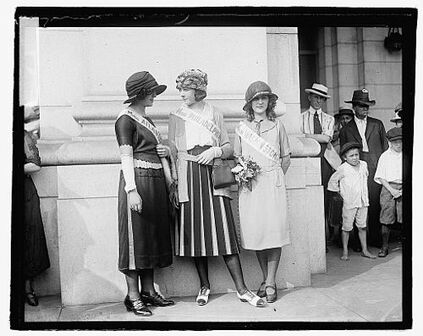 Miss America 1921, Wikimedia Commons
Miss America 1921, Wikimedia Commons
The youth culture of the 1920s featured wild celebrations of rebellion against Prohibition and other social restrictions on behavior. Dating patterns changed in the 1920s and young couples moved out of the parlor for courting, and into more public spaces. Having one beau gave way to dating more than one man for some young women. Women no longer adhered to old standards of modesty. They no longer covered their bodies at the beach, and they happily posed for photographs that documented their style. In 1921, Atlantic City, New Jersey hosted the first Inter-City Beauty Contest to attract visitors to the city over the Labor Day weekend. Entrants were judged by the public as well as a panel of judges. In the first year of the contest, Margaret Gorman of Washington D.C. won the Golden Mermaid award. She appeared in the pageant the following year as “Miss America,” and the name stuck. The “Bather’s Revue” became a hallmark of the contest in later years. Soon there were hundreds of such beauty contests in municipalities around the country.
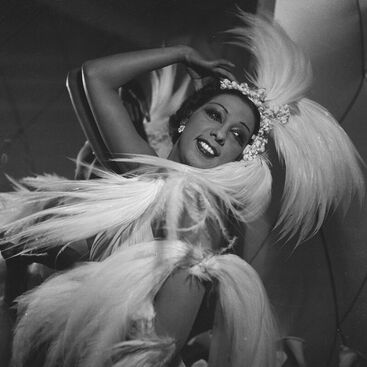 Josephine Baker, Getty Images
Josephine Baker, Getty Images
While the flapper is generally portrayed as white, Indigenous women contributed to and adopted aspects of flapper style. In fact, some scholars have argued that American interpretations of Indigenous culture and clothing influenced design choices related to stance, silhouette, color, pattern, and line. Similarly African American women also adopted the trappings of flapper style and culture. Although Madame C. J. Walker, America’s first black female millionaire, died in 1919, her beauty products company gave women the ability to control their image. The Walker Manufacturing Company’s line of hair care products was designed specifically for black women, and Madame Walker used her considerable fortune to fund scholarships and promote the cause of African-American self-help and entrepreneurship.
Josephine Baker symbolized the flapper ideal among African-American entertainers. Her career began in vaudeville and took her to Paris in 1925, where she performed in the Folies Bergere and became an immediate popular sensation. She was known for her flamboyant, if minimal, costumes and was the first African American woman to perform a lead role in a motion picture, “Siren of the Tropics,” in 1927.
Josephine Baker symbolized the flapper ideal among African-American entertainers. Her career began in vaudeville and took her to Paris in 1925, where she performed in the Folies Bergere and became an immediate popular sensation. She was known for her flamboyant, if minimal, costumes and was the first African American woman to perform a lead role in a motion picture, “Siren of the Tropics,” in 1927.
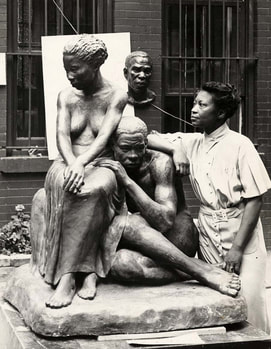 Augusta Savage, Britannica
Augusta Savage, Britannica
Harlem Renaissance:
African-American women participated in the literary and artistic movement known as the Harlem Renaissance. Women published poetry and novels and contributed to the little magazines of the period that shone a light on the lives of Black artists. Augusta Savage achieved recognition as a sculptor and Eslanda Robeson served as manager for her husband Paul Robeson. Two of the most famous writers of the period were Nella Larsen, whose novel, Passing, was about a topic long considered taboo, and Zora Neale Hurston, who told the folktales of her Florida upbringing and narrated the Black female experience.
The new medium of radio provided opportunities for female entertainers. The Lady Gatsby Jazz Band was a novelty band that featured white female singers. They sang popular tunes of the day and songs from Broadway revues.
African-American women participated in the literary and artistic movement known as the Harlem Renaissance. Women published poetry and novels and contributed to the little magazines of the period that shone a light on the lives of Black artists. Augusta Savage achieved recognition as a sculptor and Eslanda Robeson served as manager for her husband Paul Robeson. Two of the most famous writers of the period were Nella Larsen, whose novel, Passing, was about a topic long considered taboo, and Zora Neale Hurston, who told the folktales of her Florida upbringing and narrated the Black female experience.
The new medium of radio provided opportunities for female entertainers. The Lady Gatsby Jazz Band was a novelty band that featured white female singers. They sang popular tunes of the day and songs from Broadway revues.
 Black Swan Records, Wikimedia Commons
Black Swan Records, Wikimedia Commons
Record companies saw a market in Black consumers. Black Swan Records produced so- called “race records” by singers Bessie Smith, Ma Rainey, Mamie Smith, and Ethel Waters, among others. These women and others traveled throughout the south under the auspices of the Theater Owners Booking Association, which exploited them. Performers often referred to the booking agency as “Tough on Black Artists” of “Tough on Black Asses.” Singer Ethel Waters also had a career in early talking films, generally portraying a black servant and occasionally having an opportunity to sing on camera, as in the film, “Cabin in the Sky.”
Innovation and Sport:
Inside the white, middle class home, married women had access to new conveniences such as vacuum cleaners and washing machines that allegedly made housework easier. As the distance between home and men’s work increased, suburbs that served as bedroom communities for nearby cities thrived. Women’s work was home work, and the greater ease of housework was facilitated by electricity in the home. Women learned of the new labor-saving devices through advertising. Many companies targeted women in advertisements in popular magazines and on the radio. Ads sold household gadgets and processed food products that were intended to make running a household less of a chore and tied consumption to acceptance, success, and social status.
Innovation and Sport:
Inside the white, middle class home, married women had access to new conveniences such as vacuum cleaners and washing machines that allegedly made housework easier. As the distance between home and men’s work increased, suburbs that served as bedroom communities for nearby cities thrived. Women’s work was home work, and the greater ease of housework was facilitated by electricity in the home. Women learned of the new labor-saving devices through advertising. Many companies targeted women in advertisements in popular magazines and on the radio. Ads sold household gadgets and processed food products that were intended to make running a household less of a chore and tied consumption to acceptance, success, and social status.
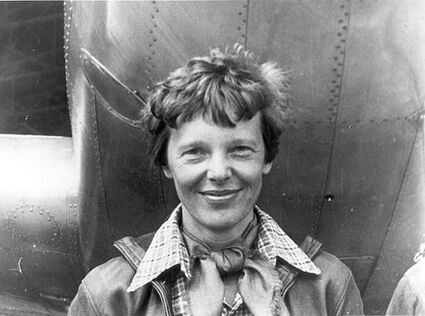 Amelia Earhart, Wikimedia Commons
Amelia Earhart, Wikimedia Commons
The 1920s was a decade of change and innovation. Women drove cars, flew planes, and bought items on credit. For the first time, a family did not need to pay cash for the latest automobile. The credit economy was launched in the 1920s.
Women entered the realm of celebrity with daring feats and athletic success. In 1921, Bessie Coleman became the first African American woman to receive a pilot's license, albeit in France because US schools refused to teach her. By 1922 she was performing in shows and advocating for more women and Black people to learn to fly. She tragically died while a passenger in a plane. In 1928, Amelia Earhart flew across the Atlantic as a passenger, the first woman to do so. Her solo transatlantic flight on May 20, 1932, the first by a woman and the second overall, was not far behind.
The 1920 Olympics in Antwerp saw participation by women for the first time. Ethelda Bleibtrey won three gold medals in swimming and 14-year old Aileen Riggin won the gold medal in springboard diving. One of the most celebrated women athletes in the 1920s was Gertrude (Trudy) Ederle. A long-distance swimmer, she was the first woman to swim across the English Channel in 1926 with a time of 14 hours and 31 minutes. Her accomplishment brought her great popularity. In 1928, Betty Robinson was the first woman to compete in running and won gold.
Women entered the realm of celebrity with daring feats and athletic success. In 1921, Bessie Coleman became the first African American woman to receive a pilot's license, albeit in France because US schools refused to teach her. By 1922 she was performing in shows and advocating for more women and Black people to learn to fly. She tragically died while a passenger in a plane. In 1928, Amelia Earhart flew across the Atlantic as a passenger, the first woman to do so. Her solo transatlantic flight on May 20, 1932, the first by a woman and the second overall, was not far behind.
The 1920 Olympics in Antwerp saw participation by women for the first time. Ethelda Bleibtrey won three gold medals in swimming and 14-year old Aileen Riggin won the gold medal in springboard diving. One of the most celebrated women athletes in the 1920s was Gertrude (Trudy) Ederle. A long-distance swimmer, she was the first woman to swim across the English Channel in 1926 with a time of 14 hours and 31 minutes. Her accomplishment brought her great popularity. In 1928, Betty Robinson was the first woman to compete in running and won gold.
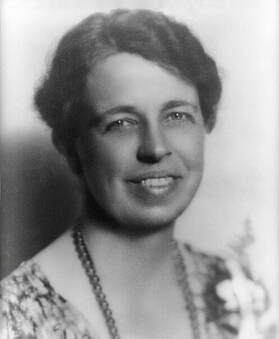 Eleanor Roosevelt, Wikimedia Commons
Eleanor Roosevelt, Wikimedia Commons
Conclusion:
The Roaring Twenties came to a crashing end on October 29, 1929. Women joined the ranks of the unemployed and evicted as the Depression worsened. Eventually, women participated in New Deal employment programs and even joined the ranks of government employees in the Roosevelt administration.
Within a few years, Americans would have a new female icon. They looked to First Lady Eleanor Roosevelt for confidence and strength in a time of great trial. The Roaring Twenties were over, but the legacy of the “New Woman” prevailed in a new form, as the First Lady served as the eyes and ears of her husband and developed a following in her own right.
By the end of this era, so much remained in question. Did women’s gains in personal freedom survive beyond the decade? How were the experiences of Black and white women different in the 1920s? How representative was the flapper image? What were the lasting legacies of the “New Woman”?
The Roaring Twenties came to a crashing end on October 29, 1929. Women joined the ranks of the unemployed and evicted as the Depression worsened. Eventually, women participated in New Deal employment programs and even joined the ranks of government employees in the Roosevelt administration.
Within a few years, Americans would have a new female icon. They looked to First Lady Eleanor Roosevelt for confidence and strength in a time of great trial. The Roaring Twenties were over, but the legacy of the “New Woman” prevailed in a new form, as the First Lady served as the eyes and ears of her husband and developed a following in her own right.
By the end of this era, so much remained in question. Did women’s gains in personal freedom survive beyond the decade? How were the experiences of Black and white women different in the 1920s? How representative was the flapper image? What were the lasting legacies of the “New Woman”?
Draw your own conclusions
|
Learn how to teach with inquiry.
Many of these lesson plans were sponsored in part by the Library of Congress Teaching with Primary Sources Eastern Region Program, coordinated by Waynesburg University, the History and Social Studies Education Faculty at Plymouth State University, and the Patrons of the Remedial Herstory Project. |
Lesson Plans from Other Organizations
- The National Women's History Museum has lesson plans on women's history.
- The Guilder Lehrman Institute for American History has lesson plans on women's history.
- The NY Historical Society has articles and classroom activities for teaching women's history.
- Unladylike 2020, in partnership with PBS, has primary sources to explore with students and outstanding videos on women from the Progressive era.
- The Roy Rosenzweig Center for History and New Media has produced recommendations for teaching women's history with primary sources and provided a collection of sources for world history. Check them out!
- The Stanford History Education Group has a number of lesson plans about women in US History.
Period Specific Lesson Plans from Other Organizations
- National History Day: Ida B. Wells (1862-1931) was born to slave parents in Holly Springs, Mississippi, on July 16, 1862, two months before President Abraham Lincoln issued the Emancipation Proclamation. As a young girl, Wells watched her parents work as political activists during Reconstruction. In 1878, tragedy struck as Wells lost both of her parents and a younger brother in a yellow fever epidemic. To support her younger siblings, Wells became a teacher, eventually moving to Memphis, Tennessee. In 1884, Wells found herself in the middle of a heated lawsuit. After purchasing a first-class train ticket, Wells was ordered to move to a segregated car. She refused to give up her seat and was forcibly removed from the train. Wells filed suit against the railroad and won. This victory was short lived, however, as the Tennessee Supreme Court overturned the lower court ruling in 1887. In 1892, Wells became editor and co-owner of The Memphis Free Speech and Headlight. Here, she used her skills as a journalist to champion the causes for African American and women’s rights. Among her most known works were those on behalf of anti-lynching legislation. Until her death in 1931, Ida B. Wells dedicated her life to what she referred to as a “crusade for justice.”
- Unladylike: In this video from Unladylike2020, learn how Rose Schneiderman, an immigrant whose family settled in the tenements of New York City’s Lower East Side, became one of the most important labor leaders in American history. A socialist and feminist, she fought to end dangerous working conditions for garment workers, and worked to help New York State grant women the right to vote in 1917. Utilizing video, discussion questions, vocabulary, and teaching tips, students learn about Schneiderman’s role in creating a better life for workers in the United States. Sensitive: This resource contains material that may be sensitive for some students. Teachers should exercise discretion in evaluating whether this resource is suitable for their class.
- Unladylike: Tye Leung Schulze became the first Chinese American woman to work for the federal government and the first Chinese American woman to vote in a U.S. election, in 1912. Learn how this inspiring woman resisted domestic servitude and an arranged child marriage to provide translation services and solace to Asian immigrant victims of human trafficking in San Francisco in this video short from Unladylike2020. Sensitive: This resource contains material that may be sensitive for some students. Teachers should exercise discretion in evaluating whether this resource is suitable for their class.
- Unladylike: Learn about Mary Church Terrell, daughter of former slaves and one of the first African American women to earn both a Bachelor and a Master’s degree, who became a national leader for civil rights and women’s suffrage, in this video from Unladylike2020. Terrell was one of the earliest anti-lynching advocates and joined the suffrage movement, focusing her life’s work on racial uplift—the belief that blacks would end racial discrimination and advance themselves through education, work, and community activism. She helped found the National Association of Colored Women (NACW) and the National Association for the Advancement of Colored People (NAACP). Support materials include discussion questions and teaching tips for research projects. Primary source analysis activities emphasize how the content connects to racial justice issues that continue today, including a close reading of the Emmett Till Antilynching Bill of 2020. Sensitive: This resource contains material that may be sensitive for some students. Teachers should exercise discretion in evaluating whether this resource is suitable for their class.
-
- Docs Teach: In this activity, students will explore the struggle for universal suffrage long after both men and women constitutionally had the right to vote. Following a progressive timeline, primary sources highlight voting problems which arose for minority groups throughout the 20th century. Students will answer questions as they work through the documents to reflect on if and when universal suffrage was ultimately achieved.
- Unladylike: Learn about the trailblazing, gender non-conforming performer Gladys Bentley with this digital short from Unladylike2020. Gladys Bentley fled her homophobic Trinidadian immigrant family in Philadelphia, PA at age 16 to join New York's Harlem Renaissance jazz scene as a cross-dressing performer. In a time when homosexuality was widely considered sinful and deviant, Bentley wore men's clothing -- a tuxedo and top hat -- and became famous for her lesbian-themed lyrics covering popular tunes of the day, and for openly flirting with women in the audience. In the 1950s, succumbing to pressure from the black church and McCarthy Era harassment of the LGBTQ community, Bentley said of her gender identity, "I am a woman again!" Constantly reinventing herself, Bentley challenged norms and pushed boundaries. Support materials include discussion questions, vocabulary, a research project on queer identity during the Harlem Rennaissance, and a close reading of Bentley's famous essay, "I am a Woman Again".
- Unladylike: Learn about Charlotta Spears Bass, a crusading newspaper editor and politician who was one of the first African American women to own and operate a newspaper in the United States, in In this video from the Unladylike2020 series. She published the California Eagle in Los Angeles from 1912 until 1951, at a time when newsrooms were male-dominated and few white journalists focused on issues of importance to African Americans. In the paper’s pages, she addressed racism, police brutality, and restrictive housing policies. Later in her career, Bass entered politics and was the first African American woman to run for Vice President of the United States in 1952. Support materials include discussion questions, primary source analysis, research project ideas, and the New York Times Magazine “1619 Project” created by Nikole Hannah-Jones.
- Unladylike: Sonora Webster Carver became one of the most famous horse divers in the world, diving 40 feet on horseback into a tank of water. Webster was blinded after one of her performances in 1931, but continued to dive horses for another 11 years. Learn how this inspiring woman persevered, undaunted by her blindness, in this video from Unladylike2020. Support materials include discussion questions, vocabulary, research extension tips, and an argument-based essay prompt.
- Unladylike: In 1916, Margaret Chung became the first American-born Chinese female doctor. Throughout her career, Chung persevered against discrimination based on her race, gender, and presumed sexuality. Learn about Chung’s inspiring career in medicine and her contributions to the U.S. war effort during WWII in this video from Unladylike2020. Support materials include discussion questions, vocabulary, a “Real Heroes” comic book analysis, and research extension tips.
- Unladylike: Explore how Bessie Coleman became the first female black pilot and the first African American to hold an international license to fly in this digital short from Unladylike2020. Using video, discussion questions, vocabulary, and a classroom activity, students learn how Coleman achieved her dream of flying during the era of Jim Crow—a time when it seemed impossible—and laid the groundwork for future African American pilots. Sensitive: This resource contains material that may be sensitive for some students. Teachers should exercise discretion in evaluating whether this resource is suitable for their class.
- Unladylike: Learn about record-breaking swimmer Gertrude Ederle who rocketed to international stardom in 1926 at the age of 20, as the first woman to swim across the English Channel in this video from the Unladylike2020 series. Considered one of the toughest endurance tests in the world, Ederle battled 21 miles of frigid water and treacherous tides between France and England to emerge on the other side of the channel. She beat the fastest man's existing record by two hours -- the first time in sports history that a woman had completed an event in a faster time than a man. Dubbed “Queen of the Waves” and “America’s Best Girl,” Ederle's accomplishment helped to demonstrate that women could be great athletes and challenged conventional wisdom about women as the so-called "weaker sex." Support materials include discussion questions, tips for research projects on female athletes, and primary source analysis. Sensitive: This resource contains material that may be sensitive for some students. Teachers should exercise discretion in evaluating whether this resource is suitable for their class.
- Unladylike: Learn about artist Meta Warrick Fuller--forerunner to the Harlem Renaissance--in this digital short from Unladylike2020. Using teaching tips, discussion questions and vocabulary, students examine the life, impact and historical era in which Warrick Fuller lived.
- Unladylike: Sissieretta Jones was heralded as one of the greatest singers of her generation and a pioneer in the operatic tradition at a time when access to most classical concert halls in the U.S. were closed to Black performers and patrons. Learn more about this trailblazing classical performer in this video from Unladylike2020. Support materials include discussion questions, vocabulary, research extension tips, and a newspaper analysis activity. Sensitive: This resource contains material that may be sensitive for some students. Teachers should exercise discretion in evaluating whether this resource is suitable for their class.
- Unladylike: Learn about Jovita Idar, a teacher, journalist, nurse, and civil rights activist who grew up in Texas and endeavored to expose segregation, lynching, and other injustices endured by Mexican Americans in the early 20th century, in this video from Unladylike2020. At a time when signs announcing “No Negroes, Mexicans, or Dogs Allowed” were common in the Southwest, she helped to tackle racism, the need for bilingual education in schools, women’s rights, and protecting the lives and property of Mexican Americans. She used journalism as a form of activism to both mobilize and educate the public. She also formed and led one of the first organizations to support the rights of Mexican American women. Support materials include discussion questions, primary source analysis, and ideas for research projects. Sensitive: This resource contains material that may be sensitive for some students. Teachers should exercise discretion in evaluating whether this resource is suitable for their class.
- Unladylike: In this digital short from Unladylike2020, students learn about Lois Weber, the first woman director of a feature film, and her impact on silent film and early Hollywood. Utilizing video, discussion questions, vocabulary and an in-class activity, students explore the life and legacy of Lois Weber and her role in the fight for women’s suffrage. Sensitive: This resource contains material that may be sensitive for some students. Teachers should exercise discretion in evaluating whether this resource is suitable for their class.
- Unladylike: Learn about actress Anna May Wong—the first Chinese American Hollywood movie star, producer and one of the most influential style icons of her time, in this resource from Unladylike2020. Throughout Wong’s career, she encountered racism and stereotyping in the roles she was offered, but in the end she found a way to flourish as an actor on her own terms starring in 60 films. Using video, discussion questions, vocabulary, teaching tips, and an in-class activity, students learn about Wong’s place in Hollywood history and how she was impacted by important events in American history, like the Chinese Exclusion Act of 1882 and anti-miscegenation laws. For additional information on the Chinese Exclusion Act, see the Chinese Exclusion Act (1882) and resource materials on PBS LearningMedia.
- Unladylike: Learn about Zitkála-Šá, also known as Gertrude Simmons Bonnin, a Yankton Sioux author, composer, and indigenous rights activist in this video from the Unladylike2020 series. Taken from her community at age 8 to attend a boarding school as part of the assimilationist policy of the U.S. government to educate Native American youth under the motto: "Kill the Indian to save the man," she used her education to advocate for American Indian rights. She trained as a violinist at the New England Conservatory of Music, and in 1913 wrote the libretto for what is considered the first Native American opera, The Sun Dance Opera. As an author, she published in prestigious national magazines such as Harper’s and The Atlantic, writing about American Indian struggles to retain tribal identities amid pressures to assimilate into European American culture. She joined the Society of American Indians, edited its publication American Indian Magazine, and in 1926 co-founded the National Council of American Indians to lobby for voting rights, sovereignty rights, and the preservation of Native American heritage and ways of life. Support materials include discussion questions, research project ideas, and primary source analysis.
-
New Priorities
Alice Paul: The Equal Rights Amendment
Famous American suffragist Alice Paul went immediately from advocating for suffrage to advocating for women’s social and economic equality. Having championed the suffrage amendment, she saw the path forward through further Constitutional amendments.
Men and women shall have equal rights throughout the United States and every place subject to its jurisdiction. Congress shall have power to enforce this article by appropriate legislation.
H.J. Res. 75, Proposing an Equal Rights Amendment to the Constitution, 12/13/1923. https://catalog.archives.gov/id/7452156.
Men and women shall have equal rights throughout the United States and every place subject to its jurisdiction. Congress shall have power to enforce this article by appropriate legislation.
H.J. Res. 75, Proposing an Equal Rights Amendment to the Constitution, 12/13/1923. https://catalog.archives.gov/id/7452156.
1920 Democratic Convention: National League of Women Voters
Not all women supported the Equal Rights Amendment. Some women, including the League of Women voters and notable suffragists like Carrie Chapman Catt claimed that “absolute equality” between men and women would strip protections for women. They proposed removing, modifying, or addressing unequal laws one at a time.
I Child Care: Prohibition of child labor, Infancy, and maternity care, Adequate appropriate for children’s bureau
II Education: Federal department of education, Increased teachers’ salaries and removal of illiteracy, Citizenship instruction
III Home and High Prices: Increased training in home economics, Federal regulation of marketing and distribution of food.
IV Women in Gainful Occupations: Representation of women on all commissions having to do with women’s occupations. Civil service re-classified on merit basis and freed from sex discrimination.
V Public Health and Morals: Continued appropriate for public education and sex hygiene.
VI Independent Citizenship for Married Women: No forfeiture of citizenship through marriage to foreigners by American born women who continue to reside in the U.S. No acquiring of citizenship by foreign born women except through individual naturalization
Planks by the National League of Women Voters, 1920 Democratic Convention, Courtesy Collection of the Oakland Museum of California.
I Child Care: Prohibition of child labor, Infancy, and maternity care, Adequate appropriate for children’s bureau
II Education: Federal department of education, Increased teachers’ salaries and removal of illiteracy, Citizenship instruction
III Home and High Prices: Increased training in home economics, Federal regulation of marketing and distribution of food.
IV Women in Gainful Occupations: Representation of women on all commissions having to do with women’s occupations. Civil service re-classified on merit basis and freed from sex discrimination.
V Public Health and Morals: Continued appropriate for public education and sex hygiene.
VI Independent Citizenship for Married Women: No forfeiture of citizenship through marriage to foreigners by American born women who continue to reside in the U.S. No acquiring of citizenship by foreign born women except through individual naturalization
Planks by the National League of Women Voters, 1920 Democratic Convention, Courtesy Collection of the Oakland Museum of California.
The Sheppard: Towner Act
The Sheppard-Towner Act (also known as the Promotion of the Welfare and Hygiene of Maternity and Infancy Act) was a law passed in 1921 under President Harding for the protection of women and children in childbirth. The law was repealed in 1929 under President Hoover. This pamphlet was used to promote the legislation. This was the first federal social welfare program, interestingly passed under a Republican presidency. Before this law, social issues were resolved at the state level. The passage of this bill was due to the political power of new “women’s organizations” including the Children's Bureau and the Women's Joint Congressional Committee, an umbrella organization of women’s organizations that fought for suffrage.
What It Is
It provides for Federal aid to the States to promote the care of maternity and infancy.
The administration for the Federal Government is to be by the U.S. Children's Bureau, under the direction of its Chief. The law permits the formation of an advisory committee consisting of the Commissioner of Education, the Surgeon-General of the U.S. Public Health Service, and the Secretary of Agriculture.
The administration in the States is to be by the Child Hygiene Divisions of State Boards of Health, in the states having such divisions, (35 States on May 1, 1921) and by other suitable State agencies in the remaining States. These divisions may be assisted by volunteer State and local advisory committees, at least half of whose members shall be women.
The State work is to consist of:
Instruction in the hygiene of maternity and infancy through public health nurses, consultation centers, and other suitable methods.
Popular, non-technical instruction in the hygiene of infancy, hygiene of maternity, and related subjects, such as the household arts which affect the well-being of mothers and children. This instruction is to be given by qualified lecturers from educational institutions, through extension courses designed particularly to reach people whom such facilities are not ordinarily accessible.
What it is Not
IT IS NOT “COMPULSORY,”—it is permissive.
No State is compelled to accept the provisions of the Act and receive its benefits, unless its legislature so desires.
No individual is under the slightest compulsion to take advantage of the opportunities for instruction and advice which the bill opens up to those who want them.
IT IS NOT “OVER-CENTRALIZATION.”—it stimulates local responsibility.
The only duty of the Children's Bureau is to ascertain that the plans proposed by the states are “in conformity with the provisions of the act and reasonably appropriate and adequate to carry out its provisions,” and to make such studies and reports as to give each state the benefit of assembled experience.
Everything else is to be done by the States. State and local authorities will employ and supervise those who do the actual work.
IT IS NOT “UNSCIENTIFIC,”—it insures expert service.
The Children's Bureau has already specially qualified physicians, nurses, and social service experts on its staff, through whom the bill will be administered.
The provision for public health nurses and consultation centers means that the practical work in the States will be done by doctors, nurses, teachers of home economics or other professional persons.
IT IS NOT “CHARITY,”—it is a public utility.
It furnishes educational facilities, paid for from public funds, exactly like the public schools.
Why it is Needed
About 200,000 BABIES DIED before they reached the age of 1 year, in 1919, in the United States.
We ranked 7th in a list of 20 countries in infant mortality; Switzerland, Sweden, Denmark, Australia, Norway and New Zealand have much lower baby death rates than the United States; Have rates barely half as high.
About 20,000 MOTHERS DIED from childbirth in 1919, in the United States.
Our maternal mortality rate is worse than that of any country in the world for which statistics are available. There are seventeen such countries. The United States ranks seventeenth.
Proper care before, during and after confinement would save the lives of about
2/3 of the mothers who die in childbirth.
½ of the babies who die before they are a year old.
This means that the Federal Government and the States, working together, Could save, every year, at least
12,000 mothers.
100,000 babies.
ARE NOT 100,000 BABIES WORTH A MILLION AND A HALF DOLLARS?
WILL NOT THE CONGRESS OF THE UNITED STATES PASS THE SHEPPARD-TOWNER BILL NOW?
Children's Bureau, “The Sheppard-Towner Bill: For the Protection of Maternity and Infancy.” 1921. Social Welfare History Image Portal, accessed November 4, 2022, https://images.socialwelfare.library
It provides for Federal aid to the States to promote the care of maternity and infancy.
The administration for the Federal Government is to be by the U.S. Children's Bureau, under the direction of its Chief. The law permits the formation of an advisory committee consisting of the Commissioner of Education, the Surgeon-General of the U.S. Public Health Service, and the Secretary of Agriculture.
The administration in the States is to be by the Child Hygiene Divisions of State Boards of Health, in the states having such divisions, (35 States on May 1, 1921) and by other suitable State agencies in the remaining States. These divisions may be assisted by volunteer State and local advisory committees, at least half of whose members shall be women.
The State work is to consist of:
Instruction in the hygiene of maternity and infancy through public health nurses, consultation centers, and other suitable methods.
Popular, non-technical instruction in the hygiene of infancy, hygiene of maternity, and related subjects, such as the household arts which affect the well-being of mothers and children. This instruction is to be given by qualified lecturers from educational institutions, through extension courses designed particularly to reach people whom such facilities are not ordinarily accessible.
What it is Not
IT IS NOT “COMPULSORY,”—it is permissive.
No State is compelled to accept the provisions of the Act and receive its benefits, unless its legislature so desires.
No individual is under the slightest compulsion to take advantage of the opportunities for instruction and advice which the bill opens up to those who want them.
IT IS NOT “OVER-CENTRALIZATION.”—it stimulates local responsibility.
The only duty of the Children's Bureau is to ascertain that the plans proposed by the states are “in conformity with the provisions of the act and reasonably appropriate and adequate to carry out its provisions,” and to make such studies and reports as to give each state the benefit of assembled experience.
Everything else is to be done by the States. State and local authorities will employ and supervise those who do the actual work.
IT IS NOT “UNSCIENTIFIC,”—it insures expert service.
The Children's Bureau has already specially qualified physicians, nurses, and social service experts on its staff, through whom the bill will be administered.
The provision for public health nurses and consultation centers means that the practical work in the States will be done by doctors, nurses, teachers of home economics or other professional persons.
IT IS NOT “CHARITY,”—it is a public utility.
It furnishes educational facilities, paid for from public funds, exactly like the public schools.
Why it is Needed
About 200,000 BABIES DIED before they reached the age of 1 year, in 1919, in the United States.
We ranked 7th in a list of 20 countries in infant mortality; Switzerland, Sweden, Denmark, Australia, Norway and New Zealand have much lower baby death rates than the United States; Have rates barely half as high.
About 20,000 MOTHERS DIED from childbirth in 1919, in the United States.
Our maternal mortality rate is worse than that of any country in the world for which statistics are available. There are seventeen such countries. The United States ranks seventeenth.
Proper care before, during and after confinement would save the lives of about
2/3 of the mothers who die in childbirth.
½ of the babies who die before they are a year old.
This means that the Federal Government and the States, working together, Could save, every year, at least
12,000 mothers.
100,000 babies.
ARE NOT 100,000 BABIES WORTH A MILLION AND A HALF DOLLARS?
WILL NOT THE CONGRESS OF THE UNITED STATES PASS THE SHEPPARD-TOWNER BILL NOW?
Children's Bureau, “The Sheppard-Towner Bill: For the Protection of Maternity and Infancy.” 1921. Social Welfare History Image Portal, accessed November 4, 2022, https://images.socialwelfare.library
Carrie Catt: Lies at Large
Renowned suffragist, Carrie Catt, defended the Shepherd-Townsend Act against accusations of Communism by its more conservative opponents. In 1926 when the bill was up for renewal and was met with organized opposition. Surprisingly, The American Medical Association saw the act as a socialist threat even though the pediatricians in their membership supported it. Their members critiqued the role of the women administrators in the Children's Bureau. They argued that women and infant health policy C. Ryan Dr. Deanna Beachley Remedial Herstory Inquiry-Based Lesson Plan 4 should be decided by the mostly male leaders in the medical field. Sadly, women’s groups like the Daughters of the American Revolution changed their minds and the anti-suffragist Woman Patriot Publishing Company accused it of being communist in nature. By January 1927, Senators filibustered calling the women who championed it "neurotic” and accused them of “pathological satisfaction in interfering with the affairs of other people.”
A SINGULAR thing is happening in this country. A group of men and women have wrought themselves up to an almost apoplectic state of mind with sheer fright over the expected coming of the Bolsheviki [communists in Russia]. The group appears to be composed of irredentist anti-suffragists, groups of the D.A.R. and other patriotic societies, some elderly army and navy men and scattered sacred souls here and there… They take themselves seriously and perform as though they actually believe what they say. THE unhappy defenders, all loaded with hate and patriotism, can not find a Bolshevik at whom to level their guns… It is safe to say that in the women’s organizations listed as dangerous and deceitful… could not find a Bolshevik. Whoever says they are red [communist], lies…The total scheme is designed to show that the Maternity Act, the Child Labor Amendment, the Educational Bill and similar legislation, are Communistic, by demonstration that all the people and organizations sponsoring them are either sympathizers with Communism or poor fools who are duped by the Bolshevists… The group opposes the Maternity Act. This, too, it seems, was ordered in Moscow. The deaths of mothers at maternity in this country was far above the mortality in other lands. The act had its origin in the desire to correct this unfortunate condition and to save the lives of mothers and babies. It appears that the reds always begin with special care of babies! The group once opposed woman suffrage, and at least two-thirds of the silly mess used now for circulation is only revamped… Entire paragraphs are lifted from those ancient documents and set into the new attacks.
Carrie Chapman Catt, "Lies-At-Large," The Woman Citizen, June 1927, pp. 10-11, 41, by Carrie Clinton Lane Chapman Catt. Included in How Did Women Peace Activists respond to "Red Scare" Attacks during the 1920s?, by Kathryn Kish Sklar and Helen Baker. (Binghamton, NY: State University of New York at Binghamton, 1998).
Questions:
A SINGULAR thing is happening in this country. A group of men and women have wrought themselves up to an almost apoplectic state of mind with sheer fright over the expected coming of the Bolsheviki [communists in Russia]. The group appears to be composed of irredentist anti-suffragists, groups of the D.A.R. and other patriotic societies, some elderly army and navy men and scattered sacred souls here and there… They take themselves seriously and perform as though they actually believe what they say. THE unhappy defenders, all loaded with hate and patriotism, can not find a Bolshevik at whom to level their guns… It is safe to say that in the women’s organizations listed as dangerous and deceitful… could not find a Bolshevik. Whoever says they are red [communist], lies…The total scheme is designed to show that the Maternity Act, the Child Labor Amendment, the Educational Bill and similar legislation, are Communistic, by demonstration that all the people and organizations sponsoring them are either sympathizers with Communism or poor fools who are duped by the Bolshevists… The group opposes the Maternity Act. This, too, it seems, was ordered in Moscow. The deaths of mothers at maternity in this country was far above the mortality in other lands. The act had its origin in the desire to correct this unfortunate condition and to save the lives of mothers and babies. It appears that the reds always begin with special care of babies! The group once opposed woman suffrage, and at least two-thirds of the silly mess used now for circulation is only revamped… Entire paragraphs are lifted from those ancient documents and set into the new attacks.
Carrie Chapman Catt, "Lies-At-Large," The Woman Citizen, June 1927, pp. 10-11, 41, by Carrie Clinton Lane Chapman Catt. Included in How Did Women Peace Activists respond to "Red Scare" Attacks during the 1920s?, by Kathryn Kish Sklar and Helen Baker. (Binghamton, NY: State University of New York at Binghamton, 1998).
Questions:
- Why was the Sheppard Act considered Communist?
- How might this claim impact other laws related to women’s rights in this Red Scare period?
H. Rept. 69-659
Mr. BACON, from the Committee on Immigration and Naturalization, submitted the following REPORT
[To accompany H. R. 6238]
The Committee on Immigration and Naturalization, to whom was referred the bill (H. R. 6238) to amend the immigration act of 1924, having had the same under consideration, unanimously reports it back to the House without amendment and recommends that the bill do pass. This bill places any woman in the nonquota class under the immigration act of 1924, who was a citizen of the United States by birth and who prior to September 22, 1922, lost her citizenship by reason of her marriage to an alien. This would permit her entry into the United States at any time as a nonquota immigrant.
H. Rept. 69-659 - Granting nonquota status to American-born women married to aliens prior to the passage of the Cable Act. March 25, 1926. -- Referred to the House Calendar and ordered to be printed. March 25, 1926.
[To accompany H. R. 6238]
The Committee on Immigration and Naturalization, to whom was referred the bill (H. R. 6238) to amend the immigration act of 1924, having had the same under consideration, unanimously reports it back to the House without amendment and recommends that the bill do pass. This bill places any woman in the nonquota class under the immigration act of 1924, who was a citizen of the United States by birth and who prior to September 22, 1922, lost her citizenship by reason of her marriage to an alien. This would permit her entry into the United States at any time as a nonquota immigrant.
H. Rept. 69-659 - Granting nonquota status to American-born women married to aliens prior to the passage of the Cable Act. March 25, 1926. -- Referred to the House Calendar and ordered to be printed. March 25, 1926.
Mary B. Talbert: Letter to State Director
Talbert was a civil rights and anti- lynching activist, suffragist, preservationist, international human rights proponent, and educator. She was born and raised in Oberlin, Ohio where she earned a college degree. She became a teacher and professor, alongside her activism in Little Rock, Arkansas.
Dear State Director:
The object of this Association shall be to unite a million women to stop lynching, The crusading is to be conducted thru prayer; and while we have designated the month of August as our month of organization, the month of September for instruction, our intensive campaign work will begin the first Sunday morning in October… for the stopping of this,--the greatest crime in America.
Miss Mary E. Jackson will be the National Organizer, and as Organizer, will be available to help… Anti-Lynching Campaign buttons will be furnished, which will be the emblem worn by every Crusader, during this Drive. We will expect you as State Director, to cover your territory, and at Richmond…
Yours for the Greatest Movement that has ever swept America, embracing both white women and black women,
Mary B. Talbert
Mary B. Talbert, Letter to State Director, 25 July 1922, NAACP Papers.
Dear State Director:
The object of this Association shall be to unite a million women to stop lynching, The crusading is to be conducted thru prayer; and while we have designated the month of August as our month of organization, the month of September for instruction, our intensive campaign work will begin the first Sunday morning in October… for the stopping of this,--the greatest crime in America.
Miss Mary E. Jackson will be the National Organizer, and as Organizer, will be available to help… Anti-Lynching Campaign buttons will be furnished, which will be the emblem worn by every Crusader, during this Drive. We will expect you as State Director, to cover your territory, and at Richmond…
Yours for the Greatest Movement that has ever swept America, embracing both white women and black women,
Mary B. Talbert
Mary B. Talbert, Letter to State Director, 25 July 1922, NAACP Papers.
Mary Church Terrel: Letter to Moorfield Storey
October 27, 1920
My dear Mr. Story:
The Republican National Committee asked me to come to New York to take charge of the work among the colored women of the Eastern States, and to perfect a permanent organisation [sic]. I have been here three weeks trying to do this, and believe I have succeeded fairly well. I consider myself the first woman victim after the Ratification of the Nineteenth Amendment north of the Mason & Dixon Line. I was arrested in Dover, Delaware, by the ticket agent five minutes after I reached the city, because I asked him if he knew a certain colored man who had been arranging meetings for the Republicans. He became angered, and charged me with “disorderly conduct”. I was not actually taken to jail. The railroad detectives refused to arrest me, and the lawyer employed by the railroad company refused to take the case. The colored women of the South will be shame-fully treated, and will not be allowed to vote, I am sure. I hope the Republicans will do something to-ward enforcing the Fifteenth Amendment. We are so helpless without the right of citizenship in that section of the country where we need it most.
Very sincerely yours,
________________________, Director
Mary Church Terrell (1863–1954) to Moorfield Storey [sic Morefield Story] (1845–1929), Carbon copy, October 27, 1920. Mary Church Terrell Papers, Manuscript Division, Library of Congress (129.00.00).
My dear Mr. Story:
The Republican National Committee asked me to come to New York to take charge of the work among the colored women of the Eastern States, and to perfect a permanent organisation [sic]. I have been here three weeks trying to do this, and believe I have succeeded fairly well. I consider myself the first woman victim after the Ratification of the Nineteenth Amendment north of the Mason & Dixon Line. I was arrested in Dover, Delaware, by the ticket agent five minutes after I reached the city, because I asked him if he knew a certain colored man who had been arranging meetings for the Republicans. He became angered, and charged me with “disorderly conduct”. I was not actually taken to jail. The railroad detectives refused to arrest me, and the lawyer employed by the railroad company refused to take the case. The colored women of the South will be shame-fully treated, and will not be allowed to vote, I am sure. I hope the Republicans will do something to-ward enforcing the Fifteenth Amendment. We are so helpless without the right of citizenship in that section of the country where we need it most.
Very sincerely yours,
________________________, Director
Mary Church Terrell (1863–1954) to Moorfield Storey [sic Morefield Story] (1845–1929), Carbon copy, October 27, 1920. Mary Church Terrell Papers, Manuscript Division, Library of Congress (129.00.00).
The Roaring Twenties
The Evening World: Those Fluttering Flappers!
Those Fluttering Flappers!
The Demi-Dame Who Is Too Young to Marry and Too Old to Believe in Santa.
Something they didn't have in the hoopskirt era was the flapper you see to-day. Up to the moment Taft slipped from President to professor and Wilson went vice versa, the flapper was practically unknown. But In the last seven or eight years she's been busting Into more prominence than a red nose and more trouble than a Red agitator…
Flappers are born not made up, but it doesn't take ‘em long to hit the red paint strides. Most of 'em graduate from low heels to high' heels and high necks to low ones before they graduate from high school… There's as much difference between a flapper and a vamp as there is between an Easter egg and a hard-boiled one. But don’t overlook the fact that to-days Easter egg can be tomorrow’s breakfast with only a little alteration…
Flapperlism is still young, but no more so than the flappers. It has spread" like the flu and It's awful ratcheting. A girl in a gingham dress has only to grab off a lavalliere, a low-neck gown and a lipstick, and right away she’s a fluttering flapper. Peary never discovered anything colder than a chiffon frock, but the flappers like 'em just the same. Eve was created too old to bon flapper, but she had flap ideas about clothes and pneumonia.
The flapper is eighteen, is practically harmless, but she’s got a large future looming before her with all her girlish curves, she grows up, be an angle in some eternal triangle. The dames that get too much' attention on the blushing side of twenty very often get too little alimony on the wrinkled side of thirty. However, eternal triangles are spicier for a boarding school Beatrice to think about than plane geometry.
But what happens after flapperhood can't scare a dame that’s studied Robert W. Chambers. A dame that isn't a flapper before she's a bride ain't ever a bride! Flap and the world flaps with you, flop and you flop alone.
The evening world. [volume] (New York, N.Y.), 20 April 1920. Chronicling America: Historic American Newspapers. Lib. of Congress. https://chroniclingamerica.loc.gov/lccn/sn83030193/1920-04-20/ed-1/seq-21/.
Question:
The Demi-Dame Who Is Too Young to Marry and Too Old to Believe in Santa.
Something they didn't have in the hoopskirt era was the flapper you see to-day. Up to the moment Taft slipped from President to professor and Wilson went vice versa, the flapper was practically unknown. But In the last seven or eight years she's been busting Into more prominence than a red nose and more trouble than a Red agitator…
Flappers are born not made up, but it doesn't take ‘em long to hit the red paint strides. Most of 'em graduate from low heels to high' heels and high necks to low ones before they graduate from high school… There's as much difference between a flapper and a vamp as there is between an Easter egg and a hard-boiled one. But don’t overlook the fact that to-days Easter egg can be tomorrow’s breakfast with only a little alteration…
Flapperlism is still young, but no more so than the flappers. It has spread" like the flu and It's awful ratcheting. A girl in a gingham dress has only to grab off a lavalliere, a low-neck gown and a lipstick, and right away she’s a fluttering flapper. Peary never discovered anything colder than a chiffon frock, but the flappers like 'em just the same. Eve was created too old to bon flapper, but she had flap ideas about clothes and pneumonia.
The flapper is eighteen, is practically harmless, but she’s got a large future looming before her with all her girlish curves, she grows up, be an angle in some eternal triangle. The dames that get too much' attention on the blushing side of twenty very often get too little alimony on the wrinkled side of thirty. However, eternal triangles are spicier for a boarding school Beatrice to think about than plane geometry.
But what happens after flapperhood can't scare a dame that’s studied Robert W. Chambers. A dame that isn't a flapper before she's a bride ain't ever a bride! Flap and the world flaps with you, flop and you flop alone.
The evening world. [volume] (New York, N.Y.), 20 April 1920. Chronicling America: Historic American Newspapers. Lib. of Congress. https://chroniclingamerica.loc.gov/lccn/sn83030193/1920-04-20/ed-1/seq-21/.
Question:
- What words does this author use to describe flappers?
Dorothy Parker: The Flapper
The playful flapper here we see,
The fairest of the fair.
She's not what Grandma used to be,--
You might say au contraire.
Her girlish ways make a stir,
Her manners cause a scene,
But there is no more harm in her
Than in a submarine.
She nightly knocks for many a goal
The usual dancing men.
Her speed is great, but her control
Is something else again.
All spotlights focus on her pranks.
All tongues her prowess herald.
For which she well may render thanks
To God or Scott Fitzgerald.
Her golden rule is plain enough
Just get them young and treat them rough.
The fairest of the fair.
She's not what Grandma used to be,--
You might say au contraire.
Her girlish ways make a stir,
Her manners cause a scene,
But there is no more harm in her
Than in a submarine.
She nightly knocks for many a goal
The usual dancing men.
Her speed is great, but her control
Is something else again.
All spotlights focus on her pranks.
All tongues her prowess herald.
For which she well may render thanks
To God or Scott Fitzgerald.
Her golden rule is plain enough
Just get them young and treat them rough.
Parker, Dorothy. “The Flapper.”
Question:
What words does this author use to describe flappers?
Question:
What words does this author use to describe flappers?
Crystal Eastman: Now We Can Begin
Eastman was a co-author of the Equal Rights Amendment with Alice Paul and a founder of the American Civil Liberties Union (ACLU). This speech, delivered in 1920 shortly after women’s suffrage was ratified, is considered one of the top 100 most influential speeches in American History.
Most women will agree that August 23, the day when the Tennessee legislature finally enacted the Federal suffrage amendment, is a day to begin with, not a day to end with. Men are saying perhaps “Thank God, this everlasting woman’s fight is over!” But women, if I know them, are saying, “Now at last we can begin.” … Now they can say what they are really after; and what they are after, in common with all the rest of the struggling world, is freedom.
Freedom is a large word…
What, then, is “the matter with women”? What is the problem of women’s freedom? It seems to me to be this: how to arrange the world so that women can be human beings, with a chance to exercise their infinitely varied gifts in infinitely varied ways, instead of being destined by the accident of their sex to one field of activity—housework and child-raising. And second, if and when they choose housework and child-raising, to have that occupation recognized by the world as work, requiring a definite economic reward and not merely entitling the performer to be dependent on some man.
This is not the whole of feminism, of course, but it is enough to begin with. “Oh, don’t begin with economics,” my friends often protest, “Woman does not live by bread alone. What she needs first of all is a free soul.” And I can agree that women will never be great until they achieve a certain emotional freedom, a strong healthy egotism, and some un-personal sources of joy — that in this inner sense we cannot make woman free by changing her economic status. What we can do, however, is to create conditions of outward freedom in which a free woman’s soul can be born and grow. It is these outward conditions with which an organized feminist movement must concern itself.
Freedom of choice in occupation and individual economic independence for women: How shall we approach this next feminist objective? First, by breaking down all remaining barriers, actual as well as legal, which make it difficult for women to enter or succeed in the various professions, to go into and get on in business, to learn trades and practice them, to join trades unions. Chief among these remaining barriers is inequality in pay…
Second, we must institute a revolution in the early training and education of both boys and girls. It must be womanly as well as manly to earn your own living, to stand on your own feet. And it must be manly as well as womanly to know how to cook and sew and clean and take care of yourself in the ordinary exigencies of life. I need not add that the second part of this revolution will be more passionately resisted than the first…
Cooperative schemes and electrical devices will simplify the business of homemaking, but they will not get rid of it entirely… The immediate feminist program must include voluntary motherhood. Freedom of any kind for women is hardly worth considering unless it is assumed that they will know how to control the size of their families. “Birth control” is just as elementary an essential in our propaganda as “equal pay.” Women are to have children when they want them, that’s the first thing…
But is there any way of insuring a woman’s economic independence while child-raising is her chosen occupation? Or must she sink into that dependent state from which, as we all know, it is so hard to rise again? That brings us to the fourth feature of our program — motherhood endowment. It seems that the only way we can keep mothers free, at least in a capitalist society, is by the establishment of a principle that the occupation of raising children is peculiarly and directly a service to society, and that the mother upon whom the necessity and privilege of performing this service naturally falls is entitled to an adequate economic reward from the political government. It is idle to talk of real economic independence for women unless this principle is accepted. But with a generous endowment of motherhood provided by legislation, with all laws against voluntary motherhood and education in its methods repealed, with the feminist ideal of education accepted in home and school, and with all special barriers removed in every field of human activity, there is no reason why woman should not become almost a human thing.
It will be time enough then to consider whether she has a soul.
Crystal Eastman, “Now We Can Begin,” Liberator (December 1920).
Most women will agree that August 23, the day when the Tennessee legislature finally enacted the Federal suffrage amendment, is a day to begin with, not a day to end with. Men are saying perhaps “Thank God, this everlasting woman’s fight is over!” But women, if I know them, are saying, “Now at last we can begin.” … Now they can say what they are really after; and what they are after, in common with all the rest of the struggling world, is freedom.
Freedom is a large word…
What, then, is “the matter with women”? What is the problem of women’s freedom? It seems to me to be this: how to arrange the world so that women can be human beings, with a chance to exercise their infinitely varied gifts in infinitely varied ways, instead of being destined by the accident of their sex to one field of activity—housework and child-raising. And second, if and when they choose housework and child-raising, to have that occupation recognized by the world as work, requiring a definite economic reward and not merely entitling the performer to be dependent on some man.
This is not the whole of feminism, of course, but it is enough to begin with. “Oh, don’t begin with economics,” my friends often protest, “Woman does not live by bread alone. What she needs first of all is a free soul.” And I can agree that women will never be great until they achieve a certain emotional freedom, a strong healthy egotism, and some un-personal sources of joy — that in this inner sense we cannot make woman free by changing her economic status. What we can do, however, is to create conditions of outward freedom in which a free woman’s soul can be born and grow. It is these outward conditions with which an organized feminist movement must concern itself.
Freedom of choice in occupation and individual economic independence for women: How shall we approach this next feminist objective? First, by breaking down all remaining barriers, actual as well as legal, which make it difficult for women to enter or succeed in the various professions, to go into and get on in business, to learn trades and practice them, to join trades unions. Chief among these remaining barriers is inequality in pay…
Second, we must institute a revolution in the early training and education of both boys and girls. It must be womanly as well as manly to earn your own living, to stand on your own feet. And it must be manly as well as womanly to know how to cook and sew and clean and take care of yourself in the ordinary exigencies of life. I need not add that the second part of this revolution will be more passionately resisted than the first…
Cooperative schemes and electrical devices will simplify the business of homemaking, but they will not get rid of it entirely… The immediate feminist program must include voluntary motherhood. Freedom of any kind for women is hardly worth considering unless it is assumed that they will know how to control the size of their families. “Birth control” is just as elementary an essential in our propaganda as “equal pay.” Women are to have children when they want them, that’s the first thing…
But is there any way of insuring a woman’s economic independence while child-raising is her chosen occupation? Or must she sink into that dependent state from which, as we all know, it is so hard to rise again? That brings us to the fourth feature of our program — motherhood endowment. It seems that the only way we can keep mothers free, at least in a capitalist society, is by the establishment of a principle that the occupation of raising children is peculiarly and directly a service to society, and that the mother upon whom the necessity and privilege of performing this service naturally falls is entitled to an adequate economic reward from the political government. It is idle to talk of real economic independence for women unless this principle is accepted. But with a generous endowment of motherhood provided by legislation, with all laws against voluntary motherhood and education in its methods repealed, with the feminist ideal of education accepted in home and school, and with all special barriers removed in every field of human activity, there is no reason why woman should not become almost a human thing.
It will be time enough then to consider whether she has a soul.
Crystal Eastman, “Now We Can Begin,” Liberator (December 1920).
Numerous: Timeline of Women in Politics
1916: First woman elected to the House of Representatives: Jeannette Rankin of MT
1922: First woman to serve in the Senate, Rebecca Felton of GE
1922: First woman to preside over the House of the Representatives, Alice Robertson of OK
1923: First woman to chair a committee in the House of Representatives, Mae Ella Nolan of CA
1931: First woman elected to the Senate, Hattie Caraway of AR
House of Representatives. “Women in Congress.” History. https://history.house.gov/Education/Fact-Sheets/WIC-FactSheet2/#:~:text=served%20in%20Congress.- ,Fast%20Facts,than%20300%20women%20have%20followed.
1922: First woman to serve in the Senate, Rebecca Felton of GE
1922: First woman to preside over the House of the Representatives, Alice Robertson of OK
1923: First woman to chair a committee in the House of Representatives, Mae Ella Nolan of CA
1931: First woman elected to the Senate, Hattie Caraway of AR
House of Representatives. “Women in Congress.” History. https://history.house.gov/Education/Fact-Sheets/WIC-FactSheet2/#:~:text=served%20in%20Congress.- ,Fast%20Facts,than%20300%20women%20have%20followed.
Numerous: History of Women in the U.S. Congress
House Report: Committee on Immigration, 1926
REPORT
…
The Committee on Immigration and Naturalization, to whom was referred the bill (H. R. 6238) to amend the immigration act of 1924, having had the same under consideration, unanimously reports it back to the House without amendment and recommends that the bill do pass. This bill places any woman in the nonquota class under the immigration act of 1924, who was a citizen of the United States by birth and who prior to September 22, 1922, lost her citizenship by reason of her marriage to an alien. This would permit her entry into the United States at any time as a nonquota immigrant.
H. Rept. 69-659 - Granting nonquota status to American-born women married to aliens prior to the passage of the Cable Act. March 25, 1926. -- Referred to the House Calendar and ordered to be printed. March 25, 1926.
…
The Committee on Immigration and Naturalization, to whom was referred the bill (H. R. 6238) to amend the immigration act of 1924, having had the same under consideration, unanimously reports it back to the House without amendment and recommends that the bill do pass. This bill places any woman in the nonquota class under the immigration act of 1924, who was a citizen of the United States by birth and who prior to September 22, 1922, lost her citizenship by reason of her marriage to an alien. This would permit her entry into the United States at any time as a nonquota immigrant.
H. Rept. 69-659 - Granting nonquota status to American-born women married to aliens prior to the passage of the Cable Act. March 25, 1926. -- Referred to the House Calendar and ordered to be printed. March 25, 1926.
Congress: Cable Act of 1922
After women gained suffrage with the Nineteenth Amendment in 1920, Congress swiftly enacted this law to restore
citizenship to U.S.-born women who had married non-citizen husbands and thereby lost their citizenship under the Expatriation Act of 1907. This law addressed the discriminatory law that set married women’s citizenship according to that of their husbands and enabled white women to retain their U.S. citizenship despite marriages to foreign men. This right did not, however, extend to women who married “aliens ineligible for citizenship,” especially Asian immigrant men.
-An Act Relative to the naturalization and citizenship of married women.
Be it enacted by the Senate and House of Representatives of the United States of America in Congress assembled, That the right of any woman to become a naturalized citizen of the United States shall not be denied or abridged because of her sex or because she is a married woman.
SEC. 2. That any woman who marries a citizen of the United States after the passage of this Act or any woman whose husband is naturalized after the passage of this Act, shall not become a citizen of the United States by reason of such marriage or naturalization ; but, if eligible to citizenship, she may be naturalized upon full and complete compliance with all requirements of the naturalization laws . . . .
SEC. 3. That a woman citizen of the United States shall not cease to be a citizen of the United States by reason of her marriage after the passage of this Act, unless she makes a formal renunciation of her citizenship before a court having jurisdiction over naturalization of aliens : Provided, That any woman citizen who marries an alien ineligible to citizenship shall cease to be a citizen of the United States . . . .
SEC. 4. That a woman who, before the passage of this Act, has lost her United States
citizenship by reason of her marriage to an alien eligible for citizenship may be naturalized as provided by section 2 of this Act . . . .
SEC. 5. That no woman whose husband is not eligible to citizen husband ship shall be naturalized during the continuance of the marital status . . . .
Approved, September 22, 1922.
United States Congress, “1922 Married Women's Citizenship Act (aka Cable Act),” Immigration History. https://immigrationhistory.org/item/cable-act/
Questions:
citizenship to U.S.-born women who had married non-citizen husbands and thereby lost their citizenship under the Expatriation Act of 1907. This law addressed the discriminatory law that set married women’s citizenship according to that of their husbands and enabled white women to retain their U.S. citizenship despite marriages to foreign men. This right did not, however, extend to women who married “aliens ineligible for citizenship,” especially Asian immigrant men.
-An Act Relative to the naturalization and citizenship of married women.
Be it enacted by the Senate and House of Representatives of the United States of America in Congress assembled, That the right of any woman to become a naturalized citizen of the United States shall not be denied or abridged because of her sex or because she is a married woman.
SEC. 2. That any woman who marries a citizen of the United States after the passage of this Act or any woman whose husband is naturalized after the passage of this Act, shall not become a citizen of the United States by reason of such marriage or naturalization ; but, if eligible to citizenship, she may be naturalized upon full and complete compliance with all requirements of the naturalization laws . . . .
SEC. 3. That a woman citizen of the United States shall not cease to be a citizen of the United States by reason of her marriage after the passage of this Act, unless she makes a formal renunciation of her citizenship before a court having jurisdiction over naturalization of aliens : Provided, That any woman citizen who marries an alien ineligible to citizenship shall cease to be a citizen of the United States . . . .
SEC. 4. That a woman who, before the passage of this Act, has lost her United States
citizenship by reason of her marriage to an alien eligible for citizenship may be naturalized as provided by section 2 of this Act . . . .
SEC. 5. That no woman whose husband is not eligible to citizen husband ship shall be naturalized during the continuance of the marital status . . . .
Approved, September 22, 1922.
United States Congress, “1922 Married Women's Citizenship Act (aka Cable Act),” Immigration History. https://immigrationhistory.org/item/cable-act/
Questions:
- What discriminatory law does this law overturn?
- What exceptions remain in the law for revoking the citizenship of women who marry an immigrant?
- Why do you think women’s citizenship status was tied to their husband’s status?
Elisabeth Adams: Women as Professional Workers
WOMEN in particular at this juncture need to take stock of their professional situation and prospects. The past five or six years have undoubtedly done much to advance and define their professional status. New doors have been set ajar and old doors set wider open. They stand at the beginning of a period which may be notable for their professional as well as their political enfranchisement and progress. But it is no time for easy optimism nor for relaxed effort. There is considerable reaction from the professional hospitalities extended during the war; and women who worked shoulder to shoulder with men are discovering that the masculine shoulder may again be coldly turned. It is a time rather for women to think clearly and resolutely about the requirements and obligations of professional life; to recognize that they cannot expect at the same time full professional recognition and the full privileges of leisure. They must admit frankly that even to-day they are far less fully and unequivocally professional than men and in many fields still professional beginners. They have special problems of their own to meet and solve, such as the basic problem of combining a professional career with marriage and parenthood. In addition, they will have to forge ahead for some time to come against a professional psychology which forgets all about them even more frequently than it objects to them, and is prone to include all women in certain sweeping generalizations…
For the present, since they are helping to establish the professional position of women, they are called upon to demonstrate courage and stability to an even greater extent than men of the same professional equipment and at the same time to avoid the pitfalls of sex rivalry or sex exploitation. In the long run, they will succeed in proportion to the extent to which they meet professional standards as workers and citizens and not as women… The professional groups of the future, far more than of the past, will be composed of both men and women, and their standards and policies will be shaped by both. Just what changes and distributions of effort this will bring about remain to be seen, although they will undoubtedly arise… The next few years will require large-mindedness and patience and imaginative insight on the part of both men and women in the professions.
Adams, Elizabeth Kemper. Women professional workers: a study made for the Women's Educational and Industrial Union. Chautauqua, N.Y.: The Chautauqua Press, 1921. https://lccn.loc.gov/21014202.
For the present, since they are helping to establish the professional position of women, they are called upon to demonstrate courage and stability to an even greater extent than men of the same professional equipment and at the same time to avoid the pitfalls of sex rivalry or sex exploitation. In the long run, they will succeed in proportion to the extent to which they meet professional standards as workers and citizens and not as women… The professional groups of the future, far more than of the past, will be composed of both men and women, and their standards and policies will be shaped by both. Just what changes and distributions of effort this will bring about remain to be seen, although they will undoubtedly arise… The next few years will require large-mindedness and patience and imaginative insight on the part of both men and women in the professions.
Adams, Elizabeth Kemper. Women professional workers: a study made for the Women's Educational and Industrial Union. Chautauqua, N.Y.: The Chautauqua Press, 1921. https://lccn.loc.gov/21014202.
Native Women, Citizenship and Sufferage
Congress: Elk v. Wilkins, 112 U.S. 94 (1884)
In Elk v. Wilkins, 112 U.S. 94 (1884), the Court found that acquisition of U.S. citizenship at birth under the Constitution if born within the United States did not extend to children of Native American tribes, holding that they were not "subject to the jurisdiction of the United States" at birth.
"[The Fourteenth Amendment] contemplates two sources of citizenship, and two sources only: birth and naturalization. The persons declared to be citizens are 'all persons born or naturalized in the United States, and subject to the jurisdiction thereof.' The evident meaning of these last words is, not merely subject in some respect or degree to the jurisdiction of the United States, but completely subject to their political jurisdiction, and owing them direct and immediate allegiance. And the words relate to the time of birth in the one case, as they do to the time of naturalization in the other. Persons not thus subject to the jurisdiction of the United States at the time of birth cannot become so afterwards, except by being naturalized, either individually, as by proceedings under the naturalization acts; or collectively, as by the force of a treaty by which foreign territory is acquired. Indians born within the territorial limits of the United States, members of, and owing immediate allegiance to, one of the Indian tribes (an alien though dependent power,) although in a geographical sense born in the United States, are no more 'born in the United States and subject to the jurisdiction thereof,' within the meaning of the first section of the Fourteenth Amendment, than the children of subjects of any foreign government born within the domain of that government, or the children born within the United States, of ambassadors or other public ministers of foreign nations."
U.S. Department of State Foreign Affairs Manual. Supreme Court Decisions. Elk v. Wilkins, 112 U.S. 94. 1884. https://fam.state.gov/fam/08fam/08fam010203.html
According to the 14th Amendment and the opinion in Elk v. Wilkins, why were native people denied citizenship?
"[The Fourteenth Amendment] contemplates two sources of citizenship, and two sources only: birth and naturalization. The persons declared to be citizens are 'all persons born or naturalized in the United States, and subject to the jurisdiction thereof.' The evident meaning of these last words is, not merely subject in some respect or degree to the jurisdiction of the United States, but completely subject to their political jurisdiction, and owing them direct and immediate allegiance. And the words relate to the time of birth in the one case, as they do to the time of naturalization in the other. Persons not thus subject to the jurisdiction of the United States at the time of birth cannot become so afterwards, except by being naturalized, either individually, as by proceedings under the naturalization acts; or collectively, as by the force of a treaty by which foreign territory is acquired. Indians born within the territorial limits of the United States, members of, and owing immediate allegiance to, one of the Indian tribes (an alien though dependent power,) although in a geographical sense born in the United States, are no more 'born in the United States and subject to the jurisdiction thereof,' within the meaning of the first section of the Fourteenth Amendment, than the children of subjects of any foreign government born within the domain of that government, or the children born within the United States, of ambassadors or other public ministers of foreign nations."
U.S. Department of State Foreign Affairs Manual. Supreme Court Decisions. Elk v. Wilkins, 112 U.S. 94. 1884. https://fam.state.gov/fam/08fam/08fam010203.html
According to the 14th Amendment and the opinion in Elk v. Wilkins, why were native people denied citizenship?
Marie Louise Bottineau Baldwin: Memoir
Marie Baldwin, a Chippewa Native, was among the first to earn a law degree in the United States. She was later appointed to the Bureau of Indian affairs, before she could even vote. She dedicated her life to improving the conditions of Native peoples.
Did you ever know that the Indian women were among the first suffragists, and that they exercised the right of recall? The trouble in this Indian question which I meet again and again is
that it is not the Indian who needs to be educated so constantly up to the white man, but that the white man needs to be educated to the Indian. Many, indeed, are the things which the paleface does not know about his red brother. Without reference or question, the attitude of tho earlier settlers has been handed down from generation to generation, as matter of course, and the
mistakes that they made are still discernible in the efforts of their descendants…
To go back to the suffragists and the right of recall. The popular idea of the Indian woman is that she was a beast of burden, with nothing but work ahead of and behind her. That she ever had a hand in the government is almost unknown. But she did, and it was a strong one. It. is true that she did most of the work, but merely because It happened to be a more natural arrangement of affairs. The brave was constantly prepared for a war. and If you have any idea that It Is an easy thing to go out and get three meals a day from the uncultivated fields and thin air just try it yourself. The Indian woman was Indeed the power behind the throne. It has been the case In many instances that the women did not like the maneuvers of the chief. What did they do? They got together and told their plans to the braves. Insisted upon a recall and & new chief and they got one. They suggested, knew and talked over the affairs of state, with their men folks, and there
was very little doing Indeed of which they were ever unaware…
There are so few of us left that It behooves us to lay aside all feeling against one another and the paleface, and make remnants' or a once mighty race, worthy of the land in which they now live.”
The Washington times. [volume] (Washington [D.C.]), 03 Aug. 1914. Chronicling America: Historic American Newspapers. Lib. of Congress. https://chroniclingamerica.loc.gov/lccn/sn84026749/1914-08-03/ed-1/seq-9/.
What was her main argument for woman suffrage and native citizenship?
Did you ever know that the Indian women were among the first suffragists, and that they exercised the right of recall? The trouble in this Indian question which I meet again and again is
that it is not the Indian who needs to be educated so constantly up to the white man, but that the white man needs to be educated to the Indian. Many, indeed, are the things which the paleface does not know about his red brother. Without reference or question, the attitude of tho earlier settlers has been handed down from generation to generation, as matter of course, and the
mistakes that they made are still discernible in the efforts of their descendants…
To go back to the suffragists and the right of recall. The popular idea of the Indian woman is that she was a beast of burden, with nothing but work ahead of and behind her. That she ever had a hand in the government is almost unknown. But she did, and it was a strong one. It. is true that she did most of the work, but merely because It happened to be a more natural arrangement of affairs. The brave was constantly prepared for a war. and If you have any idea that It Is an easy thing to go out and get three meals a day from the uncultivated fields and thin air just try it yourself. The Indian woman was Indeed the power behind the throne. It has been the case In many instances that the women did not like the maneuvers of the chief. What did they do? They got together and told their plans to the braves. Insisted upon a recall and & new chief and they got one. They suggested, knew and talked over the affairs of state, with their men folks, and there
was very little doing Indeed of which they were ever unaware…
There are so few of us left that It behooves us to lay aside all feeling against one another and the paleface, and make remnants' or a once mighty race, worthy of the land in which they now live.”
The Washington times. [volume] (Washington [D.C.]), 03 Aug. 1914. Chronicling America: Historic American Newspapers. Lib. of Congress. https://chroniclingamerica.loc.gov/lccn/sn84026749/1914-08-03/ed-1/seq-9/.
What was her main argument for woman suffrage and native citizenship?
Wilhelmina Kekelaokalaninui Widemann Dowsett: Memoir
Until the 1890s, Hawaii was ruled by an indigenous Hawaiian monarchy. It’s final queen, Queen Liliʻuokalani was overthrown by businessmen and landowners descended from American missionaries. Hawaii was annexed by the United States in 1898. Queen Liliuokalani traveled to DC to protest annexation. Other native Hawaiians like Wilhelmina Kekelaokalaninui Widemann Dowsett, took a more pragmatic approach and argued that they should have the right to suffrage since they had it in Hawaii. Dowsett founded the National Women’s Equal Suffrage Association and hosted meetings in her home. Hawaiian women became enfranchised with the 19th Amendment, but as residents of a U.S. territory, their representation was limited until Hawaii became a state on August 21, 1959.
Sister Hawaiians, our foreign sisters are with us. Senator Wise asked us yesterday if the so-called ‘society women’ were leading us, and we told him that this was not so. We are working all together, and we want the legislature to know this. And we must also remember our Oriental sisters, who are not here today but who will also unite this great cause.
National Park Service. “Wilhelmina Kekelaokalaninui Widemann Dowsett.” https://www.nps.gov/people/wilhelmina-kekelaokalaninui-widemann-dowsett.htm.
What was her main argument for woman suffrage and native citizenship?
Sister Hawaiians, our foreign sisters are with us. Senator Wise asked us yesterday if the so-called ‘society women’ were leading us, and we told him that this was not so. We are working all together, and we want the legislature to know this. And we must also remember our Oriental sisters, who are not here today but who will also unite this great cause.
National Park Service. “Wilhelmina Kekelaokalaninui Widemann Dowsett.” https://www.nps.gov/people/wilhelmina-kekelaokalaninui-widemann-dowsett.htm.
What was her main argument for woman suffrage and native citizenship?
Zitkala-Sa: Memoir
Zitkala-Ša grew up in boarding schools designed to strip native children of their indigenous cultures. There she adopted the name Gertrude Simmons Bonnin, which she later abandoned. She was a Native American suffragist, writer and activist until her death in 1938. After women got the vote, Zitkala-Sa became an advocate for the Snyder Act of 1924 which granted full citizenship to Native Americans.
I remember my mother. I was born in a teepee. I loved that life. It was beautiful, more beautiful than I can tell you. But my mother said to me. “You must learn the white man’s language so when you grow up you will talk for us and for the Indian and the white man will have a better understanding.” I said…“I am going to do the best I can and then I am going to let the Great Spirit do the rest.” … Then I think I have forgotten the most important thing of all, and that is our Maker the Great Spirit. We must keep our faith in the Great Spirit because this applied to every day thinking in our homes and wherever we go.
Then let us have level heads. let us not cower. We are men and women with minds and hearts. Why, the Great Almighty made us! We are here like other human beings and there is no reason why we should be afraid to hold up our heads. Let us stand up straight. Let us study conditions; let us give reasons why. And if we fail at the first trial, shall we quit? No, we will try again. You believe in right—then stand for that… We must continue speaking and claiming our human rights to live on this earth that God has made, so that we may think our thoughts and speak them—that we may have our part in the American life and be as any other human beings are…
We are rational beings. Let us develop our powers by thinking and acting for ourselves. That is the way we grow… I have been in sessions of Congress when the great men there met together. They will discuss their subjects, some on one side, some on another, both giving soundest arguments. Was it treason for these men to have difference of opinions? It was not treason against the Government. They were representing their people, they were representing the Government, but they had different views and they had the privilege of speaking… We are in America, and we have, each one of us, a right to express our views. We agree on the main thing… We want the privilege of rational men for, were we idiots or lunatics we would not be here, we would be in some hospital or asylum. But, because we are rational creatures, we have a right to express our thoughts and to try to come to some plan, according to the best of our light. This is our policy.
Bonnin, Gertrude (Zitkala-Sa). “Address by Mrs. Gertrude Bonnin.” The American Indian, Vol. 7, No. 3 (1919). Delivered to the Annual Convention of the Society of American Indians. 2-4 October 1919.
What was her main argument for woman suffrage and native citizenship?
I remember my mother. I was born in a teepee. I loved that life. It was beautiful, more beautiful than I can tell you. But my mother said to me. “You must learn the white man’s language so when you grow up you will talk for us and for the Indian and the white man will have a better understanding.” I said…“I am going to do the best I can and then I am going to let the Great Spirit do the rest.” … Then I think I have forgotten the most important thing of all, and that is our Maker the Great Spirit. We must keep our faith in the Great Spirit because this applied to every day thinking in our homes and wherever we go.
Then let us have level heads. let us not cower. We are men and women with minds and hearts. Why, the Great Almighty made us! We are here like other human beings and there is no reason why we should be afraid to hold up our heads. Let us stand up straight. Let us study conditions; let us give reasons why. And if we fail at the first trial, shall we quit? No, we will try again. You believe in right—then stand for that… We must continue speaking and claiming our human rights to live on this earth that God has made, so that we may think our thoughts and speak them—that we may have our part in the American life and be as any other human beings are…
We are rational beings. Let us develop our powers by thinking and acting for ourselves. That is the way we grow… I have been in sessions of Congress when the great men there met together. They will discuss their subjects, some on one side, some on another, both giving soundest arguments. Was it treason for these men to have difference of opinions? It was not treason against the Government. They were representing their people, they were representing the Government, but they had different views and they had the privilege of speaking… We are in America, and we have, each one of us, a right to express our views. We agree on the main thing… We want the privilege of rational men for, were we idiots or lunatics we would not be here, we would be in some hospital or asylum. But, because we are rational creatures, we have a right to express our thoughts and to try to come to some plan, according to the best of our light. This is our policy.
Bonnin, Gertrude (Zitkala-Sa). “Address by Mrs. Gertrude Bonnin.” The American Indian, Vol. 7, No. 3 (1919). Delivered to the Annual Convention of the Society of American Indians. 2-4 October 1919.
What was her main argument for woman suffrage and native citizenship?
Matilda Gage: Memoir
Gage was a white suffragist and an author alongside Susan B. Anthony and Elizabeth Cady Stanton of the dense History of Women’s Suffrage. She was also an advocate for Native rights and citizenship.
The famous Iroquois Indians, or Six Nations… showed alike in form of government, and in social life, reminiscences of the Matriarchate. The line of descent, feminine, was especially notable in all tribal relations such as the election of Chiefs, and the Council of Matrons, to which all disputed questions were referred for final adjudication. No sale of lands was valid without consent of the squaws… The women also possessed the veto power on questions of war… If for any cause the Iroquois husband and wife separated, the wife took with her all the property she had brought into the wigwam; the children also accompanied the mother, whose right to them was recognized as supreme… Not alone the Iroquois but most Indians of North America trace descent in the female line; among some tribes woman enjoys almost the whole legislative authority and in others a prominent share… Thus to the Matriarchate or Mother-rule is the modern world indebted for its first conception of inherent rights, natural equality of condition, and the establishment of a civilized government upon this basis. Although the reputation of the Iroquois as warriors appears most prominent in history, we nevertheless find their real principles to have been the true Matriarchal one of peace and industry. Driven from the northern portion of America by vindictive foes, compelled to take up arms in self-protection, yet the more peaceful occupations of hunting and agriculture were continually followed.
Gage, Matilda Josyln. Woman, Church & State. Project Gutenberg, 2014. Originally published in 1983. https://www.gutenberg.org/files/45580/45580-h/45580-h.htm.
The famous Iroquois Indians, or Six Nations… showed alike in form of government, and in social life, reminiscences of the Matriarchate. The line of descent, feminine, was especially notable in all tribal relations such as the election of Chiefs, and the Council of Matrons, to which all disputed questions were referred for final adjudication. No sale of lands was valid without consent of the squaws… The women also possessed the veto power on questions of war… If for any cause the Iroquois husband and wife separated, the wife took with her all the property she had brought into the wigwam; the children also accompanied the mother, whose right to them was recognized as supreme… Not alone the Iroquois but most Indians of North America trace descent in the female line; among some tribes woman enjoys almost the whole legislative authority and in others a prominent share… Thus to the Matriarchate or Mother-rule is the modern world indebted for its first conception of inherent rights, natural equality of condition, and the establishment of a civilized government upon this basis. Although the reputation of the Iroquois as warriors appears most prominent in history, we nevertheless find their real principles to have been the true Matriarchal one of peace and industry. Driven from the northern portion of America by vindictive foes, compelled to take up arms in self-protection, yet the more peaceful occupations of hunting and agriculture were continually followed.
Gage, Matilda Josyln. Woman, Church & State. Project Gutenberg, 2014. Originally published in 1983. https://www.gutenberg.org/files/45580/45580-h/45580-h.htm.
Chinese Women, Citizenship and Sufferage
Congress: Chinese Exclusion Act
This act provided an absolute 10-year ban on Chinese laborers immigrating to the United States. When the exclusion act expired in 1892, Congress extended it for 10 years in the form of the Geary Act. This extension, made permanent in 1902, added restrictions by requiring each Chinese resident to register and obtain a certificate of residence. Without a certificate, they faced deportation. In 1943, when China was a member of the Allied Nations during World War II, Congress repealed all the exclusion acts, but the quotas remained. True reform did not come until the 1990s and the act was condemned by congress in 2011.
An Act to execute certain treaty stipulations relating to Chinese.
Whereas in the opinion of the Government of the United States the coming of Chinese laborers to this country endangers the good order of certain localities within the territory thereof: Therefore,
Be it enacted… That… after the passage of this act… it shall not be lawful for any Chinese laborer to come, or having so come after the expiration of said ninety days to remain within the United States.
…SEC. 12. That no Chinese person shall be permitted to enter the United States by land without producing to the proper officer of customs the certificate in this act required of Chinese persons seeking to land from a vessel…
SEC. 14. That hereafter no State court or court of the United States shall admit Chinese to citizenship; and all laws in conflict with this act are hereby repealed…
Approved, May 6, 1882.
An act to execute certain treaty stipulations relating to the Chinese, May 6, 1882; Enrolled Acts and Resolutions of Congress, 1789-1996; General Records of the United States Government; Record Group 11; National Archives.
Women and the Chinese community are left “Out in the cold” in this 1884 magazine cover.
An Act to execute certain treaty stipulations relating to Chinese.
Whereas in the opinion of the Government of the United States the coming of Chinese laborers to this country endangers the good order of certain localities within the territory thereof: Therefore,
Be it enacted… That… after the passage of this act… it shall not be lawful for any Chinese laborer to come, or having so come after the expiration of said ninety days to remain within the United States.
…SEC. 12. That no Chinese person shall be permitted to enter the United States by land without producing to the proper officer of customs the certificate in this act required of Chinese persons seeking to land from a vessel…
SEC. 14. That hereafter no State court or court of the United States shall admit Chinese to citizenship; and all laws in conflict with this act are hereby repealed…
Approved, May 6, 1882.
An act to execute certain treaty stipulations relating to the Chinese, May 6, 1882; Enrolled Acts and Resolutions of Congress, 1789-1996; General Records of the United States Government; Record Group 11; National Archives.
Women and the Chinese community are left “Out in the cold” in this 1884 magazine cover.
Tye Leung Schulze: Excerpt
On May 19, 1912 Tye Leung made history as the first Chinese woman to vote in the United States and potentially the world because California granted women, including her, the vote in 1911. She was not blocked by the Chinese Exclusion Act. This is an interview she gave about the experience.
My first vote? - Oh, yes, I thought long over that. I studied; I read about all your men who wished to be president. I learned about the new laws. I wanted to KNOW what was right, not to act blindly...I think it right we should all try to learn, not vote blindly, since we have been given this right to say which man we think is the greatest...I think too that we women are more careful than the men. We want to do our whole duty more. I do not think it is just the newness that makes use like that. It is conscience.
Tye Leung Schulze cited by the National Parks Service. https://www.nps.gov/people/tye-leung-schulze.htm.
My first vote? - Oh, yes, I thought long over that. I studied; I read about all your men who wished to be president. I learned about the new laws. I wanted to KNOW what was right, not to act blindly...I think it right we should all try to learn, not vote blindly, since we have been given this right to say which man we think is the greatest...I think too that we women are more careful than the men. We want to do our whole duty more. I do not think it is just the newness that makes use like that. It is conscience.
Tye Leung Schulze cited by the National Parks Service. https://www.nps.gov/people/tye-leung-schulze.htm.
Mabel Ping Hua-Lee: Article
Not all Chinese women could vote in the US because the Page Act and the Chinese Exclusion Act discriminated against and blocked many Chinese immigrants from full citizenship in the United States. Lee was an outspoken feminist who spoke publicly about woman suffrage and Chinese rights throughout her childhood. In 1912, she led Chinese and Chinese-American women in a New York City suffrage parade. She earned a PhD from Columbia University. When women’s suffrage was ratified in 1920, she still was unable to vote. Chinese-American immigrants could not vote until 1943 with the passage of the Magnuson Act. Mabel Lee died in 1966 and it is unknown if she ever voted in the US.
CHINESE GIRL WANTS VOTE
Miss Lee Ready to Enter Barnard, to Ride in Suffrage Parade.
Regarding her as the symbol of the new era, when all their women will be free and unhampered, all Chinatown is proud of Little Miss Mabel Lee, daughter of the mission pastor, Dr. Lee Towe, plant accomplishments. Her parents brought her to this country seven years ago, and she learned quickly so much of English, Latin and mathematics that she is now prepared to enter Barnard College.
Miss Lee inherits from her father a strong mind and an admiration for American institutions. The mind is, indeed, so strong that it compels her to look through what she considers the one defect in the institutions -namely, the limited franchise. She thinks that should be extended to women. Therefore she intends to March in the suffrage parade on May 4th. No, not march, but ride on horseback, in Miss Annie R Tinker’s brigade of horse women who will head the procession. She will be clad, like the rich and fashionable suffragettes around her, in a tight fitting black broadcloth habit and a Tri cornered black hat, with the green, purple and white cockade of the Woman's Political Union.
When the tribune reporter saw her yesterday at her home, No. 53 Bayard street however, she was in her school dress- a plain Chinese jumper, similar to the American middy blouse, a blue serge skirt and very American black patent leather pumps. Clinging to her skirt was a baby sister in a red Chinese jacket, and the long straight pantaloons which most Chinese wear in their homes, even in New York.
Miss Lee's mother is the link that holds her and her missionary father bound to the old era. Mrs. Lee Towe has a feet about two inches long, encased in red slippers, and she seldom goes out of the house. She would have to descend four flights of stairs to do so, but it is not a question of comfort only. She is high caste, and it would not be seemly for her to walk in the streets, observed of men.
Miss Lee means to learn all she can of American ways and to go back to China to teach her sisters there. She believes that woman's place is in the home, and that her education should be primarily for the satisfaction of her husband.
“How can a marriage be happy?” she asked, “unless the wife is educated enough to understand and sympathize with her husband in his business and intellectual interests.” That seems to be the great difference between the American and the Chinese ideals of education period the Chinese ideal is to make the girl a comfort and delight to her parents and later to her husband. The American ideal is to help the girl towards her own improvement for her own pleasure.
“It seems to me that each nation has something to learn from the other.”
New-York tribune. [volume] (New York [N.Y.]), 13 April 1912. Chronicling America: Historic American Newspapers. Lib. of Congress. https://chroniclingamerica.loc.gov/lccn/sn83030214/1912-04-13/ed-1/seq-3/.
Miss Lee Ready to Enter Barnard, to Ride in Suffrage Parade.
Regarding her as the symbol of the new era, when all their women will be free and unhampered, all Chinatown is proud of Little Miss Mabel Lee, daughter of the mission pastor, Dr. Lee Towe, plant accomplishments. Her parents brought her to this country seven years ago, and she learned quickly so much of English, Latin and mathematics that she is now prepared to enter Barnard College.
Miss Lee inherits from her father a strong mind and an admiration for American institutions. The mind is, indeed, so strong that it compels her to look through what she considers the one defect in the institutions -namely, the limited franchise. She thinks that should be extended to women. Therefore she intends to March in the suffrage parade on May 4th. No, not march, but ride on horseback, in Miss Annie R Tinker’s brigade of horse women who will head the procession. She will be clad, like the rich and fashionable suffragettes around her, in a tight fitting black broadcloth habit and a Tri cornered black hat, with the green, purple and white cockade of the Woman's Political Union.
When the tribune reporter saw her yesterday at her home, No. 53 Bayard street however, she was in her school dress- a plain Chinese jumper, similar to the American middy blouse, a blue serge skirt and very American black patent leather pumps. Clinging to her skirt was a baby sister in a red Chinese jacket, and the long straight pantaloons which most Chinese wear in their homes, even in New York.
Miss Lee's mother is the link that holds her and her missionary father bound to the old era. Mrs. Lee Towe has a feet about two inches long, encased in red slippers, and she seldom goes out of the house. She would have to descend four flights of stairs to do so, but it is not a question of comfort only. She is high caste, and it would not be seemly for her to walk in the streets, observed of men.
Miss Lee means to learn all she can of American ways and to go back to China to teach her sisters there. She believes that woman's place is in the home, and that her education should be primarily for the satisfaction of her husband.
“How can a marriage be happy?” she asked, “unless the wife is educated enough to understand and sympathize with her husband in his business and intellectual interests.” That seems to be the great difference between the American and the Chinese ideals of education period the Chinese ideal is to make the girl a comfort and delight to her parents and later to her husband. The American ideal is to help the girl towards her own improvement for her own pleasure.
“It seems to me that each nation has something to learn from the other.”
New-York tribune. [volume] (New York [N.Y.]), 13 April 1912. Chronicling America: Historic American Newspapers. Lib. of Congress. https://chroniclingamerica.loc.gov/lccn/sn83030214/1912-04-13/ed-1/seq-3/.
Mable Ping Hua-Lee: Speech
I plead for a wider sphere of usefulness for the long submerged women of China. I ask for our girls the open door to the treasury of knowledge, the same opportunities for physical development as boys and the same rights of participation in all human activities of which they are individually capable.
An old custom based on a false philosophy deprived her of the choice of her mate. An iniquitous Still, all that is but a beginning. The great mass of the people has yet to be aroused to the necessity for action. The neglect and indifference to women’s welfare in the past must be remedied --- Not only laws must be passed in the interest of the future mothers of the new Republic, but they must be religiously enforced. Prejudice must be removed and a healthy public sentiment created to support the progressive movement.
In furtherance of such a cause we students should take a leading part. To us girls especially, who are among the first to emerge, will fall the duties of pioneers and, if we do our share, ours will be the honor and the glory.
The welfare of China and possibly its very existence as an independent nation depends on rendering tardy justice to its womankind. For no nation can ever make real and lasting progress in civilization unless its women are following close to its men if not actually abreast with them.
In the fierce struggle for existence among the nations, that nation is badly handicapped which leaves undeveloped one half of its intellectual and moral resources.
If, according to President Lincoln, the Federal Union could not endure half free, half slave, how can China maintain her position among independent nations half free and taught, half shackled in body and in mind?
Lee, Mabel. “China’s Submerged Half.” 1915.
An old custom based on a false philosophy deprived her of the choice of her mate. An iniquitous Still, all that is but a beginning. The great mass of the people has yet to be aroused to the necessity for action. The neglect and indifference to women’s welfare in the past must be remedied --- Not only laws must be passed in the interest of the future mothers of the new Republic, but they must be religiously enforced. Prejudice must be removed and a healthy public sentiment created to support the progressive movement.
In furtherance of such a cause we students should take a leading part. To us girls especially, who are among the first to emerge, will fall the duties of pioneers and, if we do our share, ours will be the honor and the glory.
The welfare of China and possibly its very existence as an independent nation depends on rendering tardy justice to its womankind. For no nation can ever make real and lasting progress in civilization unless its women are following close to its men if not actually abreast with them.
In the fierce struggle for existence among the nations, that nation is badly handicapped which leaves undeveloped one half of its intellectual and moral resources.
If, according to President Lincoln, the Federal Union could not endure half free, half slave, how can China maintain her position among independent nations half free and taught, half shackled in body and in mind?
Lee, Mabel. “China’s Submerged Half.” 1915.
Remedial Herstory Editors. "17. THE NEW WOMAN." The Remedial Herstory Project. November 20, 2022. www.remedialherstory.com.
Primary AUTHOR: |
Dr. Barbara Tischler
|
Primary ReviewerS: |
Dr. Deanna Beachley
|
Consulting TeamKelsie Brook Eckert, Project Director
Coordinator of Social Studies Education at Plymouth State University Dr. Barbara Tischler, Consultant Professor of History Hunter College and Columbia University Dr. Alicia Gutierrez-Romine, Consultant Assistant Professor of History at La Sierra University Jacqui Nelson, Consultant Teaching Lecturer of Military History at Plymouth State University Dr. Deanna Beachley Professor of History and Women's Studies at College of Southern Nevada |
EditorsReviewersColonial
Dr. Margaret Huettl Hannah Dutton Dr. John Krueckeberg 19th Century Dr. Rebecca Noel Michelle Stonis, MA Annabelle L. Blevins Pifer, MA Cony Marquez, PhD Candidate 20th Century Dr. Tanya Roth Dr. Jessica Frazier Mary Bezbatchenko, MA Dr. Alicia Gutierrez-Romine Matthew Cerjak |
|
Looks at the role of women in postwar America, discussing the common perceptions of women at the time--including flappers and housewives--and illustrating how they were reflected in the magazines, catalogs, and films of the time.
This is the story of America’s first sexual revolution, its first merchants of cool, its first celebrities, and its most sparkling advertisement for the right to pursue happiness. The men and women who made the flapper were a diverse lot.
|
In the wake of the Great Migration of thousands of African Americans from the scattered hamlets and farms of the rural South to the nation's burgeoning cities, a New Negro ethos of modernist cultural expression and potent self-determination arose to challenge white supremacy and create opportunities for racial advancement.
Ignorant. Brutal. Male. One of these stereotypes of the Ku Klux Klan offers a misleading picture. In Women of the Klan, sociologist Kathleen M. Blee dismantles the popular notion that politically involved women are always inspired by pacifism, equality, and justice. In her new preface, Blee reflects on how recent scholarship on gender and right-wing extremism suggests new ways to understand women's place in the 1920s Klan's crusade for white and Christian supremacy.
|
The Harlem Renaissance was a cultural movement that saw an explosion of Black art, music and writing, yet few female creatives are remembered alongside their male counterparts. Exploring subjects from love, loss and motherhood to jazz, passing and Jim Crow law, the poems and stories collected in this anthology celebrate the women of color at the heart of the Harlem Renaissance.
|
|
The Empty Mirror chronicles the parallel lives of Frances Austin and Addie Stanford, two women who come of age in the Roaring Twenties. Born in small-town Pennsylvania, the women independently move to New York City during the wildest years of the Jazz Age. Their trials in business and love reveal the rapidly changing roles of women in society.
Harlem, 1926. Young Black women like Louise Lloyd are ending up dead. When a girl turns up dead in front of the café, Louise is forced to confront something she’s been trying to ignore - two other local Black girls have been murdered in the past few weeks. After an altercation with a police officer gets her arrested, Louise is given an ultimatum: She can either help solve the case or wind up in a jail cell. Louise has no choice but to investigate and soon finds herself toe-to-toe with a murderous mastermind hell-bent on taking more lives, maybe even her own....
|
The Roaring Twenties—the Jazz Age—has been characterized as a time of Gatsby frivolity. But it was also the height of the uniquely American hate group, the Ku Klux Klan. And the man who set in motion their takeover of great swaths of America was a charismatic charlatan named D.C. Stephenson. But at the peak of his influence, it was a seemingly powerless woman–Madge Oberholtzer–who would reveal his secret cruelties, and whose deathbed testimony finally brought the Klan to their knees.
|
Sallie Kincaid is the daughter of the biggest man in a small town, the charismatic Duke Kincaid. By the time she is just eight years old, the Duke has remarried and had a son, Eddie. When Sallie tries to teach young Eddie to be more like their father, her daredevil coaching leads to an accident, and Sallie is cast out. Nine years later, she returns, determined to reclaim her place in the family. That’s a lot more complicated than Sallie expected, and she enters a world of conflict and lawlessness. Sallie confronts the secrets and scandals that hide in the shadows of the Big House, navigates the factions in the family and town, and finally comes into her own as a bold, sometimes reckless bootlegger.
|
How to teach with Films:
Remember, teachers want the student to be the historian. What do historians do when they watch films?
- Before they watch, ask students to research the director and producers. These are the source of the information. How will their background and experience likely bias this film?
- Also, ask students to consider the context the film was created in. The film may be about history, but it was made recently. What was going on the year the film was made that could bias the film? In particular, how do you think the gains of feminism will impact the portrayal of the female characters?
- As they watch, ask students to research the historical accuracy of the film. What do online sources say about what the film gets right or wrong?
- Afterward, ask students to describe how the female characters were portrayed and what lessons they got from the film.
- Then, ask students to evaluate this film as a learning tool. Was it helpful to better understand this topic? Did the historical inaccuracies make it unhelpful? Make it clear any informed opinion is valid.
|
The Roosevelts is a documentary that dives deep into the lives and work of Teddy, Franklin, and Eleanor Roosevelt.
IMDB |
|
|
The Color Purple (2023)
A decades-spanning tale of love and resilience and of one woman's journey to independence. Celie faces many hardships in her life, but ultimately finds extraordinary strength and hope in the unbreakable bonds of sisterhood. IMDB |
|
Bibliography
Karen Anderson, Changing Woman: A History of Racial Ethnic Women in Modern America (NY: Oxford University Press, 1996).
Beth Bailey, From Front Porch to Back Seat: Courtship in Twentieth-Century America (Baltimore:The Johns Hopkins University Press,1989, second edition).
Dana Ramey Berry and Kali Nicole Gross, A Black Women’s History of the United States (Boston: Beacon Press, 2020), Chapter 7, “Augusta’s Clay, Migration, and the Depression, 1915-1940,” pp. 123-142.
Kathleen M. Blee, Women of the Klan: Racism and Gender in the 1920s (Berkeley: University of California Press, 1991)
Linda Gordon, The Second Coming of the KKK: The Ku Klux Klan of the 1920s and the American Political Tradition (NY: Liveright Publishing Corp, 2017), Chapter 7, “KKK Feminism”, pp. 109-137.
Darlene Clark Hine and Kathleen Thompson, Shining Thread of Hope: The History of Black Women in America (NY: Broadway Press, 1998), Chapter 8, “No Mountain too High,” pp. 192-212.
Vicki L. Ruiz, From Out of the Shadows: Mexican American Women in Twentieth-Century America (NY: Oxford University Press, 1998), Chapter 3, “The Flapper and the Chaperone,” pp. 51-71.
Beth Bailey, From Front Porch to Back Seat: Courtship in Twentieth-Century America (Baltimore:The Johns Hopkins University Press,1989, second edition).
Dana Ramey Berry and Kali Nicole Gross, A Black Women’s History of the United States (Boston: Beacon Press, 2020), Chapter 7, “Augusta’s Clay, Migration, and the Depression, 1915-1940,” pp. 123-142.
Kathleen M. Blee, Women of the Klan: Racism and Gender in the 1920s (Berkeley: University of California Press, 1991)
Linda Gordon, The Second Coming of the KKK: The Ku Klux Klan of the 1920s and the American Political Tradition (NY: Liveright Publishing Corp, 2017), Chapter 7, “KKK Feminism”, pp. 109-137.
Darlene Clark Hine and Kathleen Thompson, Shining Thread of Hope: The History of Black Women in America (NY: Broadway Press, 1998), Chapter 8, “No Mountain too High,” pp. 192-212.
Vicki L. Ruiz, From Out of the Shadows: Mexican American Women in Twentieth-Century America (NY: Oxford University Press, 1998), Chapter 3, “The Flapper and the Chaperone,” pp. 51-71.
